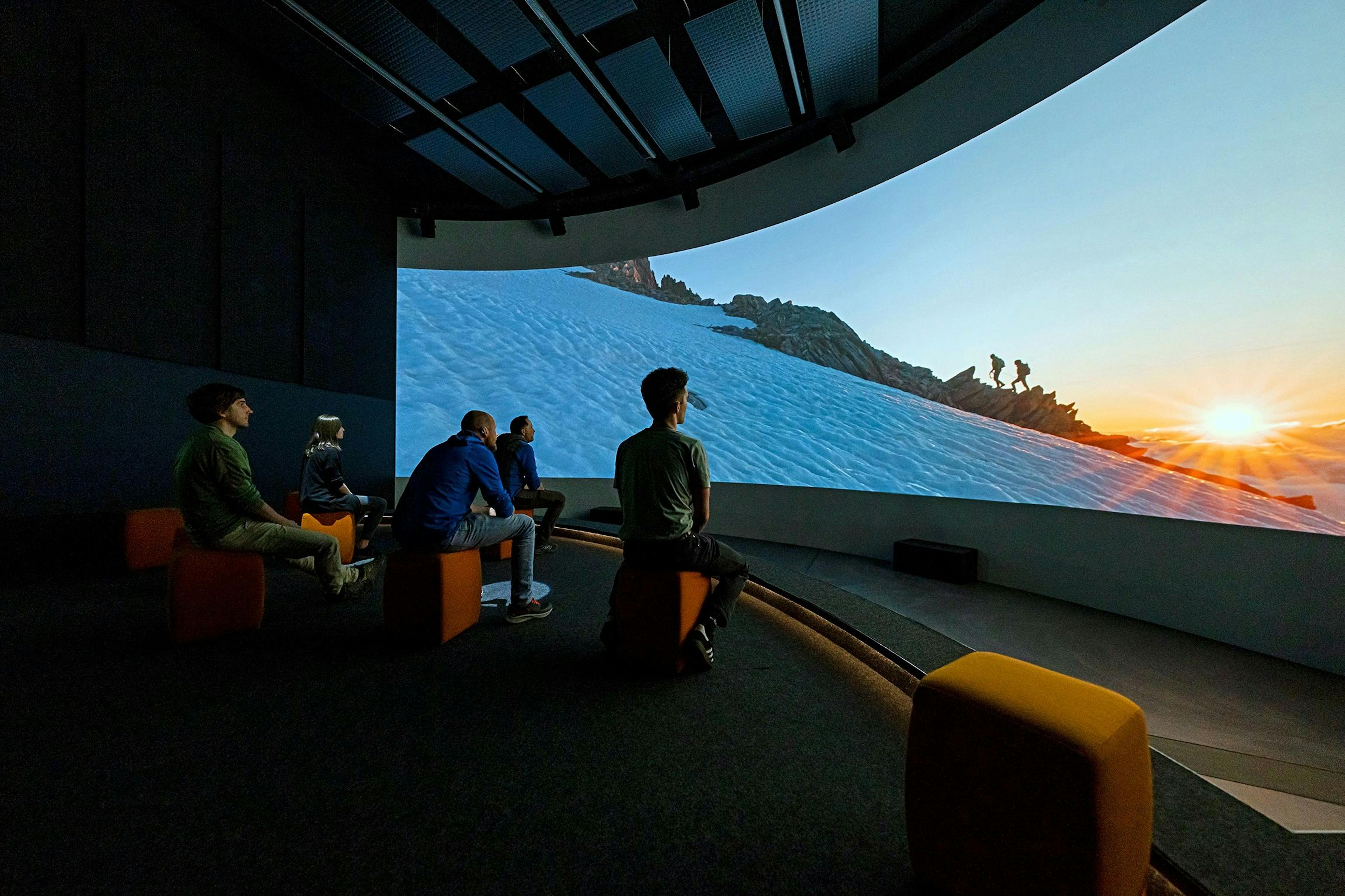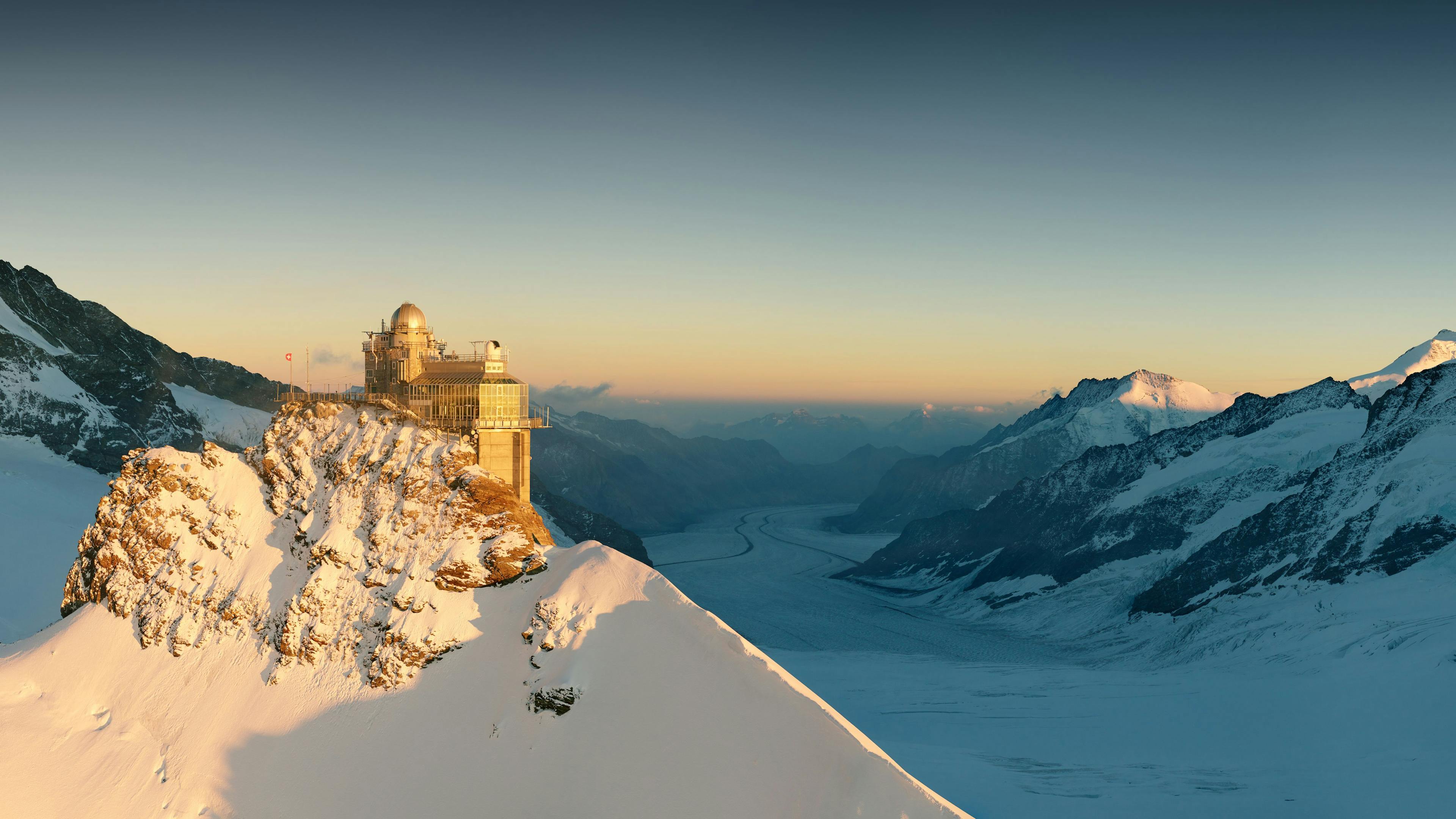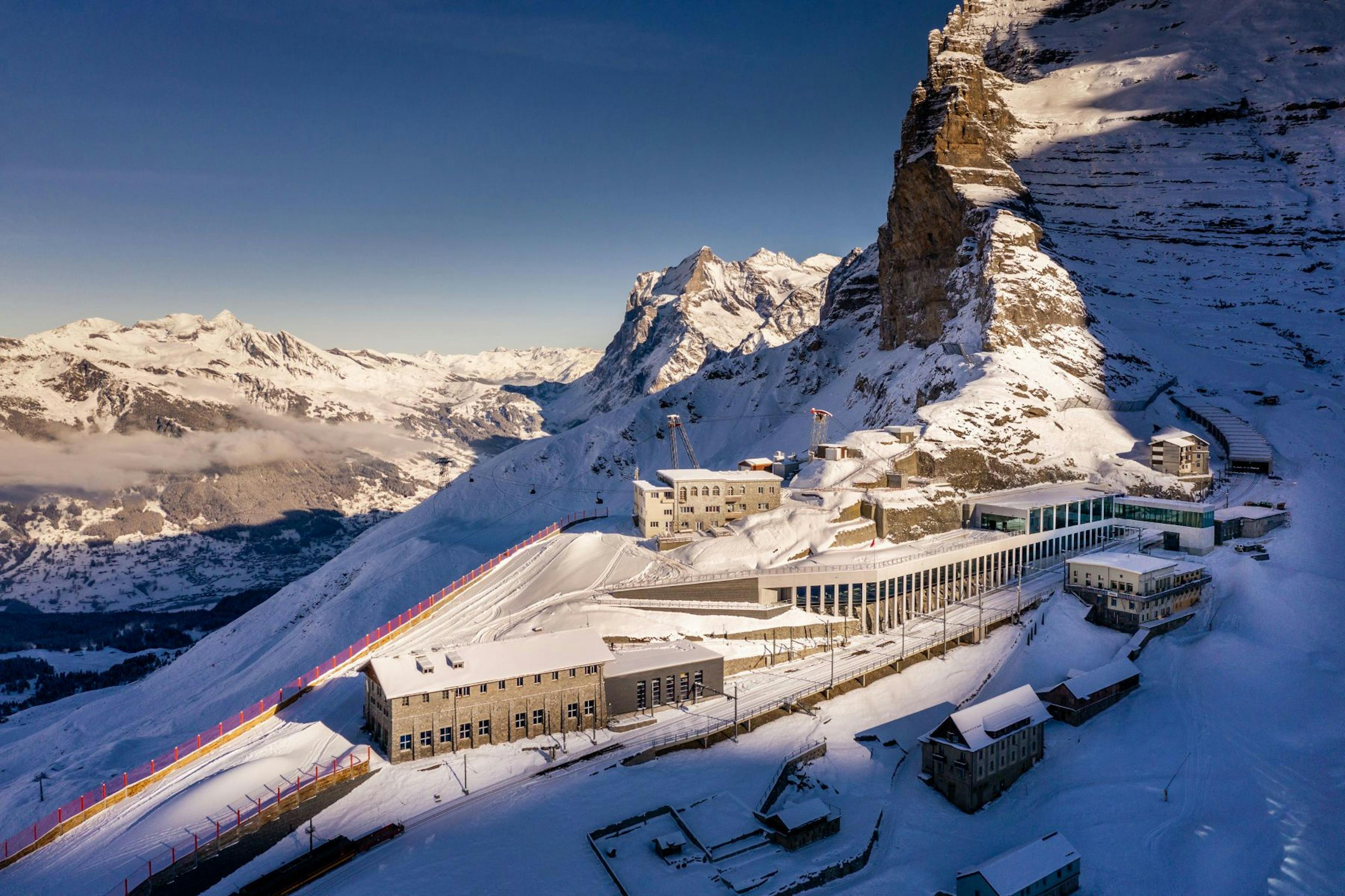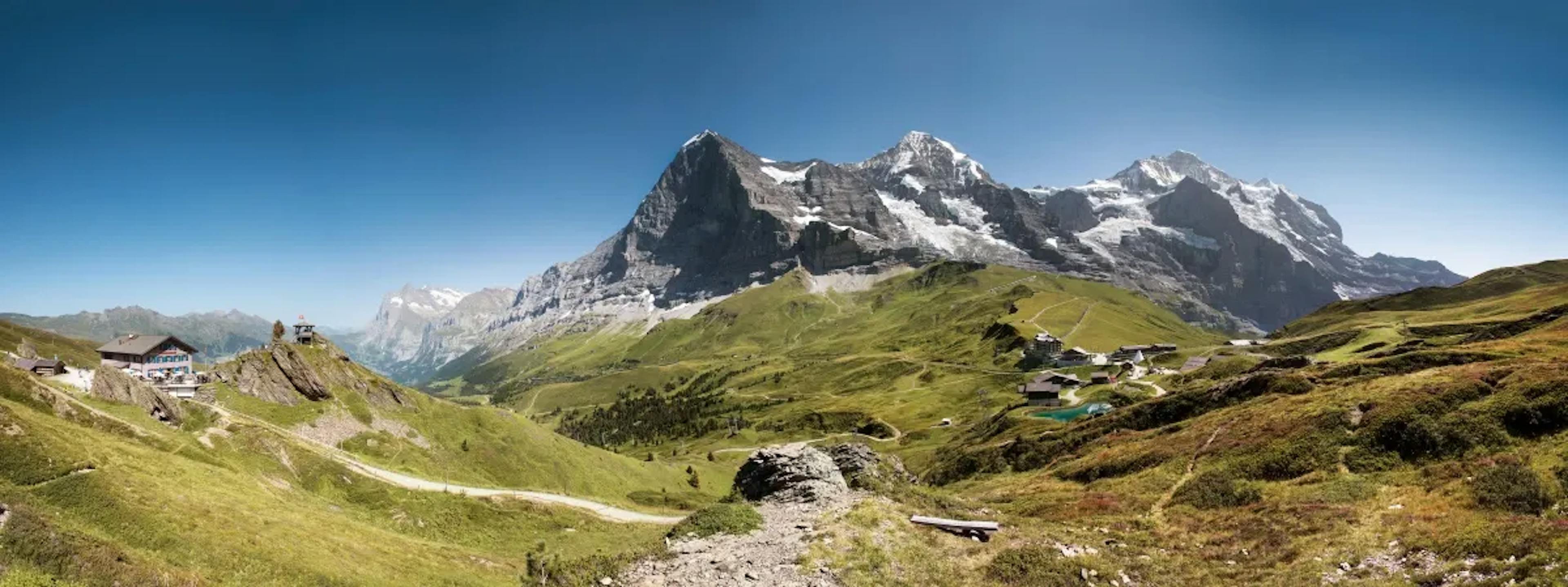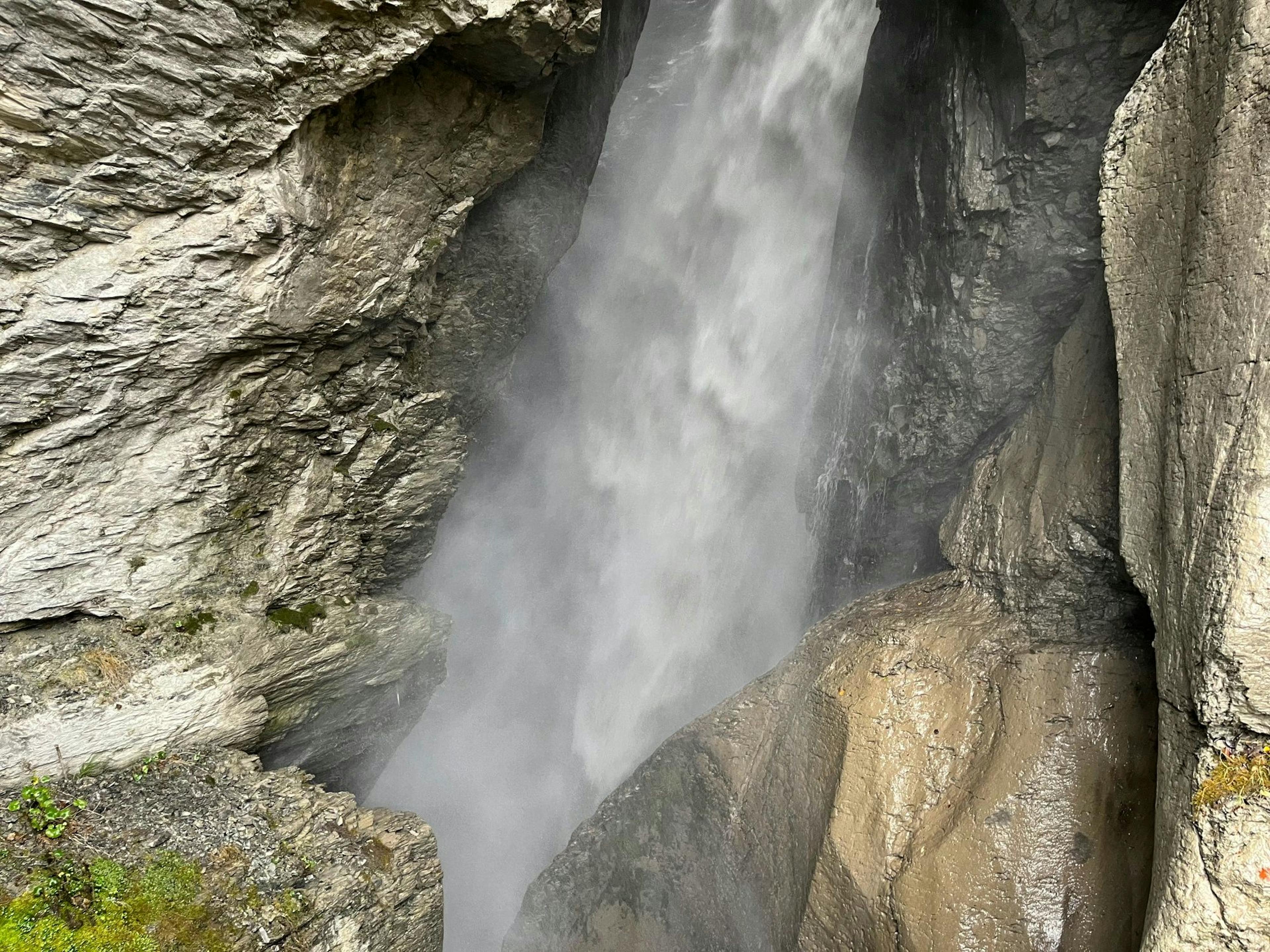Just like the Aletsch Glacier itself and the Jungfraujoch, the Aletsch Forest and the Aletsch Arena are part of the Jungfrau Aletsch UNESCO World Natural Heritage Site.
11 Highlights of the Aletsch Arena
- The Aletsch Arena lies at 2000 to 2900 m above sea level.
- It includes the areas of the municipalities of Mörel-Filet, Riederalp, Bettmeralp, Fiesch, Fieschertal and Lax as well as the associated mountain railroads of Bettmeralp, Fiescheralp and Riederalp.
- The Aletsch Plateau is the sunny plateau of the Aletsch Arena and completely car-free.
- 35 lifts and mountain railroads together transport up to almost 42000 people per hour.
- 4 panoramic peaks give a direct view of the glaciers
- 80 m high and 126 m long is the famous Massa Gorge suspension bridge "Aletsch". It is located between Riederalp and Belalp.
- The Aletsch forest is spread between 1600 and 2200 m above sea level. It connects the Great Aletsch Glacier with the Aletsch Arena.
- At 2000 m above sea level and close to Bettmeralp, Lake Bettmer was formed on an area of 6 hectares.
- The chain of lakes Märjelenseen is located at altitudes from 2302 m above sea level. It was originally formed from a huge glacial lake.
- At least 6 climbing possibilities (via ferrata, climbing garden, rope parks) attract climbing enthusiasts to the Aletsch Arena
- Countless mountain bike routes are available in the car-free area and are very popular.
Popular places in the Aletsch Arena are viewpoints that allow a direct view of the Great Aletsch Glacier. The enormous ice, which gets a little smaller every year, fascinates every visitor. The quiet Aletsch forest, which stretches along the glacier, is also a popular place to visit.
Bettmeralp has a special weather phenomenon to offer. Since it is located above the Rhone valley, it happens in winter that the sun shines on Bettmeralp and there is high fog in the valley. This leads to particularly beautiful views.
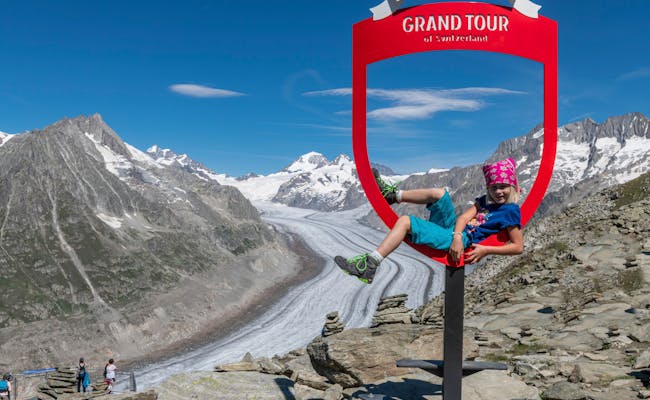 Rundweg Eggishorn (Foto: Chantal Stucky Aletsch Arena AG)
Rundweg Eggishorn (Foto: Chantal Stucky Aletsch Arena AG)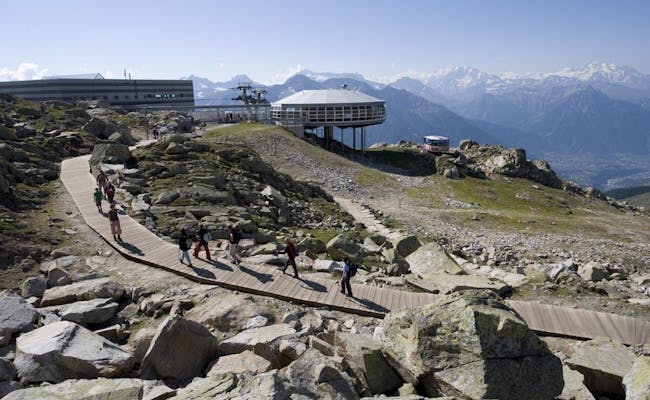 Panorama Restaurant Bettmerhorn (Foto: Aletsch Arena)
Panorama Restaurant Bettmerhorn (Foto: Aletsch Arena)Sights of the Aletsch Arena
Mountain lakes exert a special attraction. Their clear water and healthy fish population have something calming for the whole family. It is a good place to rest, take a cool swim or go boating on the lake, especially in high summer.
Sights in and around the Aletsch Arena include:
- Aletsch Glacier
- Fieschergletscher
- the four lookout peaks on the Aletsch Arena
- Massaschlucht suspension bridge "Aletsch
- Aletsch forest
- Lake Bettmer
- the Märjelen lakes
- Pro Natura Center Aletsch - Villa Cassel
Aletsch Glacier near the Aletsch Arena
The Aletsch Glacier has its origin in the Jungfrau region, which is located about 4000 meters above sea level. It counts as the core of the UNESCO World Heritage Site Swiss Alps Jungfrau-Aletsch.
Three mighty firn fields flow together with the small Grüneckfirn at Konkordiaplatz The mighty firn fields include:
- the Grosse Aletschfirn
- the Jungfraufirn and
- the Ewigschneefeld.
The Great Aletsch Glacier is thus formed at the Konkordiaplatz. The Konkordiaplatz is six square kilometers in size and the ice thickness here is more than 900 meters.
The Great Aletsch Glacier continues to flow towards the Rhone Valley at a speed of about 200 meters per year. Under the pressure of the mighty ice masses, valleys were and are formed and rocks are abraded.
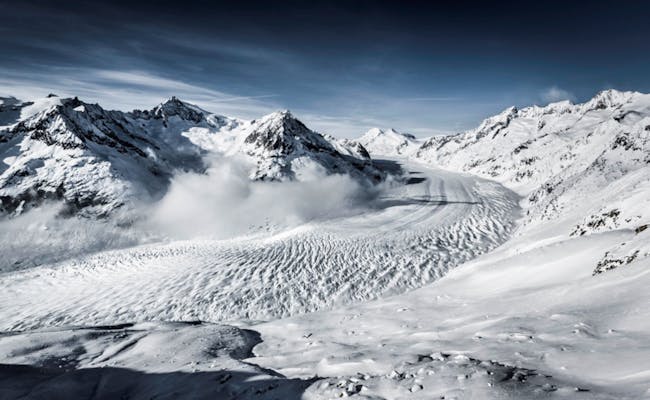 Aletschgletscher Winter (Foto: (c)Huber Frederic Aletsch Arena)
Aletschgletscher Winter (Foto: (c)Huber Frederic Aletsch Arena)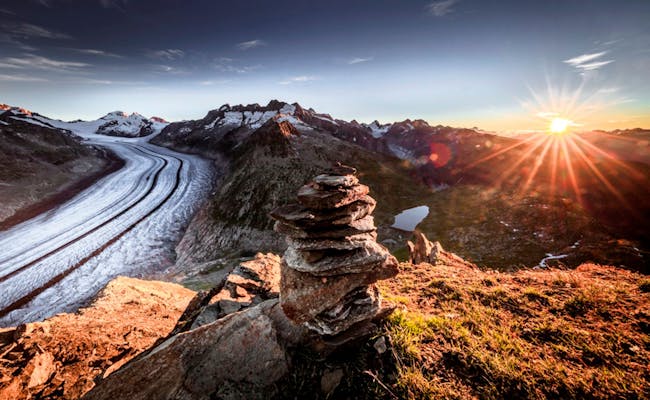 Aletschgletscher Sonnenaufgang (Foto: (c)Huber Frederic Aletsch Arena)
Aletschgletscher Sonnenaufgang (Foto: (c)Huber Frederic Aletsch Arena)Fieschergletscher
The Fieschergletscher is a valley glacier located east of the Aletsch Glacier. It is about 14.7 kilometers long. After the Aletsch Glacier, it is still considered the longest glacier in the Alps. In terms of total area, it is the third largest glacier in the Alps. Its area in 2017 was just under 30 m². In terms of area, the Aletsch Glacier is also the largest glacier, but in second place comes the Gorner Glacier.
The Fieschergletscher is relatively narrow as it squeezes through between Wannenhorn and Wasenhorn. It ends at a large rock bar that divides the glacier into two glacier tongues at high elevations. The last highstand was in the 17th century. Today there is a measuring station at the outflow of the Fieschergletscher.
 Fiescheralp Tlligrattunnel zum Gletscherrand (Foto: Aletsch Arena)
Fiescheralp Tlligrattunnel zum Gletscherrand (Foto: Aletsch Arena) 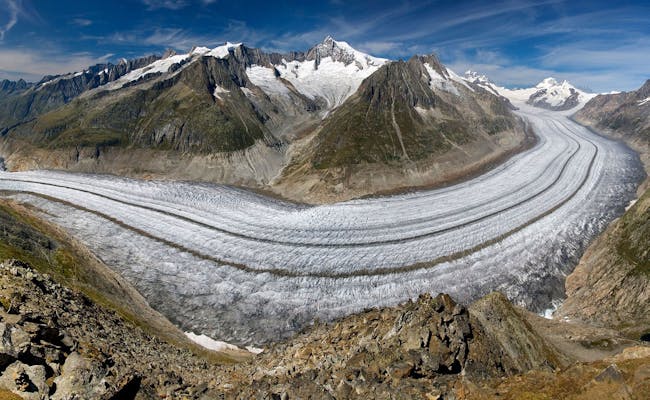 Eggishorn via Maerjelensee (Foto: Aletsch Arena)
Eggishorn via Maerjelensee (Foto: Aletsch Arena)The four lookout peaks on the Aletsch Arena
A breathtaking panorama can be viewed from all the lookout peaks. Jungfrau; Mönch and Eiger can be seen in the north, as well as Finsteraarhorn and Wannenhorn. Matterhorn, Mischabel group, Dom and Weisshorn are discovered in the south. Most impressive is the 23-kilometer-long Aletsch Glacier. It is the longest glacier in the Alps.
All four View Points are on the route of the "Grand Tour of Switzerland" by Switzerland Tourism. Because of the altitude, temperatures are always crisp here, but the weather is usually settled. Therefore, at all four View Points the unobstructed view is almost always very good.
View Point Eggishorn 2869 m a.s.l.
The view point Eggishorn is the highest of the four view points in the Aletsch Arena. From here you can see the entire 23 kilometers of the Aletsch Glacier. The view even goes as far as Konkordiaplatz. Jungfrau, Mönch and Eiger are always in view anyway.
There is a photo spot at this vantage point. The Horli- Hitta provides refreshments. The View Point Eggishorn can be reached with the Aletsch Bahnen from Fiesch via Fiescheralp and from the mountain station there you continue with the cable car to the Eggishorn. From the second mountain station it is another 400 m on foot.
Bettmerhorn 2647 m above sea level.
The second highest vantage point in the Aletsch Arena looks out over the long straight and the big curve of the Aletsch Glacier. This is also regularly the finish of the Aletsch Half Marathon.
The Bettmerhorn Panorama Restaurant provides visitors with food and drinks. The multimedia exhibition Gletscherwelt Bettmerhorn provides comprehensive information about the Great Aletsch Glacier and its secrets. At Bettmerhorn, the viewpoint is barrier-free.
The Bettmerhorn vantage point can be reached from the Betten valley station by cable car to Bettmeralp. There, a 15-minute walk leads to the gondola lift on the other side of the village. The cable car goes directly to the Bettmerhorn.
Swiss Activities offer:
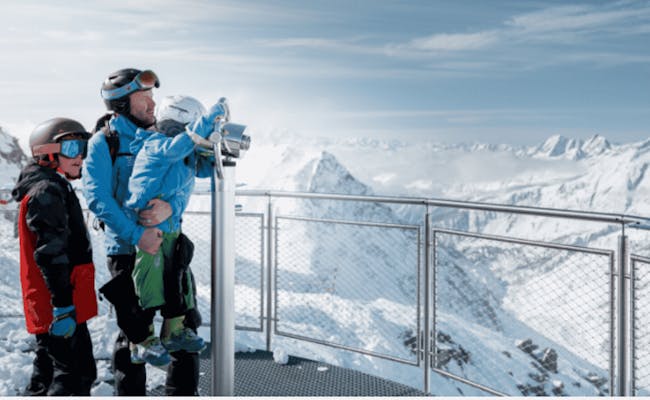 Eggishorn Viewpoint (Foto: Aletsch Arena)
Eggishorn Viewpoint (Foto: Aletsch Arena)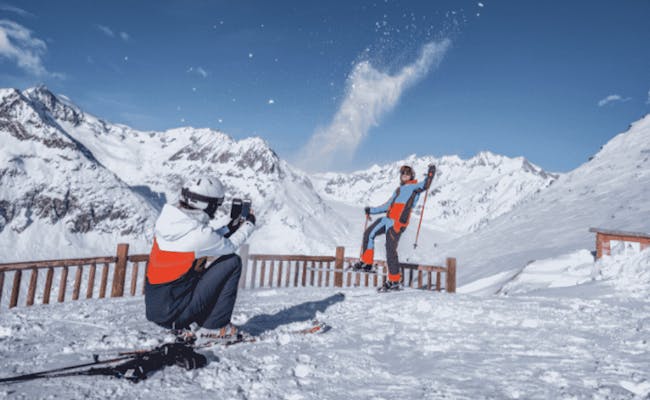 Bettmerhotn Viewpoint (Foto: Aletsch Arena)
Bettmerhotn Viewpoint (Foto: Aletsch Arena)Moosfluh 2333 m above sea level.
The viewpoint Moosfluh is not far from Hohfluh. A telescope allows you to look very far over the glacier and into the mountains. The neighboring Bar Buvette provides snacks and refreshments.
The Moosfluh is reached from Mörel with the Aletsch cable cars, first to Riederalp Mitte. Here you change to the Moosfluh glacier lift. It consists of gondolas in summer and is a combination of gondolas and chairs in winter.
Hohfluh 2227 m above sea level.
The View Point Hohfluh looks over the curves of the Aletsch Glacier. Due to the proximity to the Moosfluh, the combination of both view points is recommended.
This viewpoint can be reached with the Aletsch cable cars from Mörel to Riederalp Mitte or Riederalp West. To Hohfluh, the chairlift departs from Riederalp.
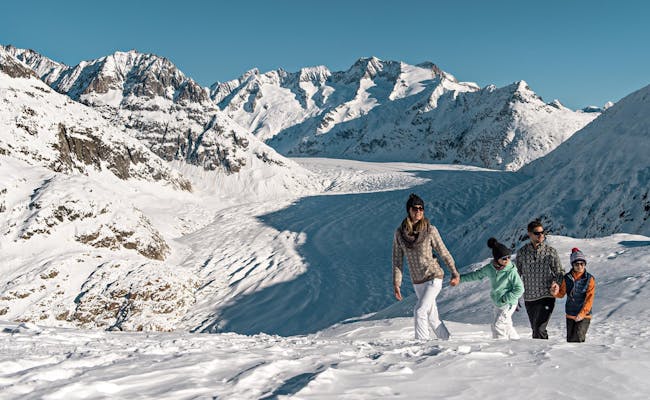 Moosfluh Viewpoint (Foto: Aletsch Arena)
Moosfluh Viewpoint (Foto: Aletsch Arena)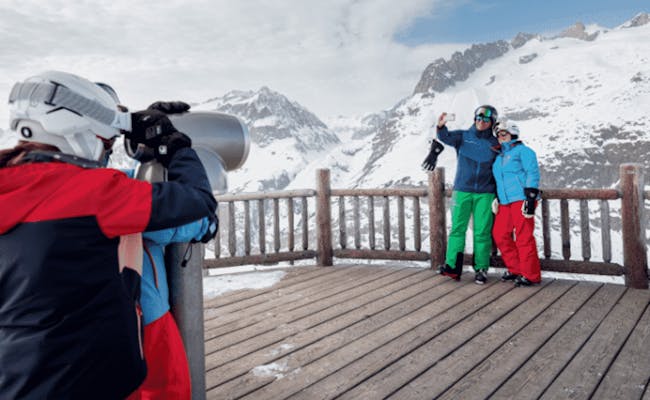 Hohfluh Viewpoint (Foto: Aletsch Arena)
Hohfluh Viewpoint (Foto: Aletsch Arena)Massaschlucht suspension bridge "Aletsch" between Riederalp and Belalp
It is only a short walk from Riederalp via Riederfurka, the Teiffe forest and the Grünsee biotope to the suspension bridge. At a height of 80 m and a length of 126 m, it spans the Massa gorge and the Aletsch glacier melting in it. The bridge was built in recognition of the fact that, due to the melting process, crossing the glacier is no longer possible at this point. The approximately four-hour hikes to or from Belalp are popular.
The Aletsch Forest
The Aletsch Forest lies below the Jungfraujoch and above the southwestern edge of the glacier. It connects the Great Aletsch Glacier with the Aletsch Arena. It lies in the subalpine altitude zone between 1600 and 2200 m above sea level on the northwestern and northern slopes of Moosfluh and Hohfluh.
The forest consists in its upper part of larches and stone pines (Swiss stone pines), which are loosely distributed over the area. In between, the ground is covered with low shrubs and blueberries and heather. The shrubs are mostly alpine roses, which bloom widely here in July. There are also raised bogs in the area of the Aletsch Forest.
The unique feature of this forest is the lateral moraines newly colonized by plants, where the glacier has already retreated. Here, the individual stages of recolonization by the plants can be clearly seen. In the beginning there are first mosses, then saxifrages appear and in the last stage there are ancient stone pine trees.
Living in the forest:
- Marmots
- Chamois
- Black grouse
- Nutcracker
- Golden eagle
- Red deer (only in summer)
Since fir jays feed mainly on pine nuts, they ensure the spread of the pine trees. They can be observed in the forest especially in autumn when the nuts crack loudly in the trees.
Since 2001, the Aletsch Forest has been part of the Swiss Alps Jungfrau-Aletsch UNESCO World Heritage Site. It is also part of a hunting ban area. Hunting is prohibited here.
Lake Bettmer in the Aletsch Arena
Lake Bettmersee is located at just under 2000 meters above sea level and covers an area of about six hectares. You can swim and fish in the cool lake in summer (Thursday closed day), surf or go boating. Stand Up Paddling is a newly added sport at the lake. For children there is a natural paddling pool at Lake Bettmer.
- Boat rental: daily from 10 a.m. to 6 p.m. (mid-June to mid-October)
- Fishing: Day permits are available at the boathouse, at the Infocenter Bettmeralp, or at the community office for CHF 20.
- Infocenter Bettmeralp, telephone 0041-27 928 58 58.
To get to Lake Bettmer, take the cable car to Bettmeralp. From there you can reach the lake in a few minutes.
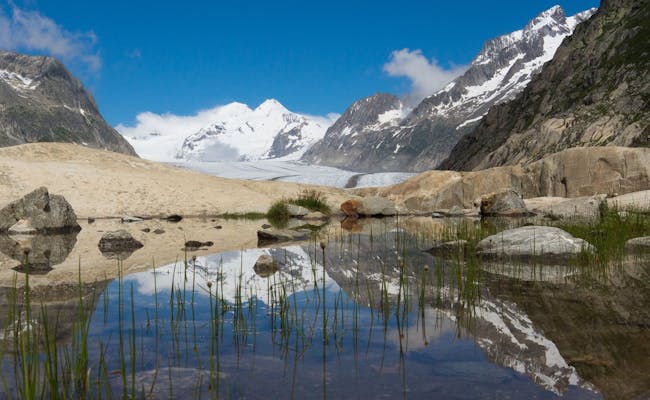 Fiescheralp nach Bellwald (Foto: Aletsch Arena)
Fiescheralp nach Bellwald (Foto: Aletsch Arena)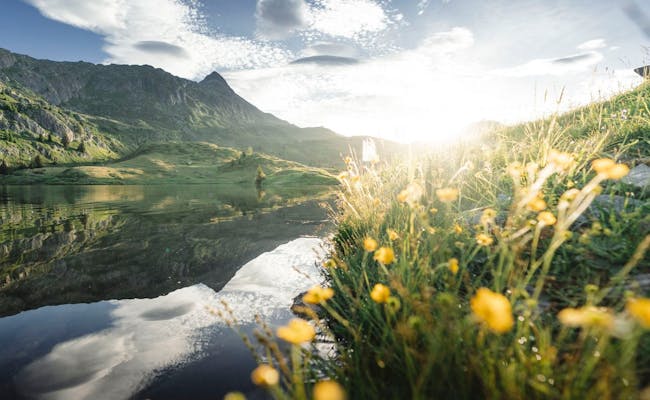 Bettmersee (Foto: Aletsch Arena)
Bettmersee (Foto: Aletsch Arena)Marmot learning trail
The marmot learning trail leads to Lake Bettmer from the east (Bättmer-Hüttli). From the top station of the Bettmeralp cable car, hikers reach the chairlift in an easterly direction. One of the two chairlifts Wurzenbord or Schönbiel is open in summer. You can read about this on the Status Report page of the Aletsch lifts. Along the way, there are four stops with information boards that provide information about the marmots. On this trail, the chances are good to observe some of the shy animals directly.
The Märjelen lakes in the Aletsch Arena
A small chain of lakes lies on the eastern edge of the Aletsch Glacier. They are found in a depression at an altitude of 2302 m above sea level and are fed by the Aletsch Glacier. The depression is flanked by the Eggishorn (2927 m above sea level) and the Strahlhorn (3026.5 m above sea level). The mountain hut Gletscherstube is located directly at the lakes.
In the 19th century, it was still a large lake that was dammed up to form the Gletscherrandsee. At that time it was about 1.6 km long and 500 m wide. The sudden outflow of the lake through crevasses often caused great floods in the Massa valley. Today, the largest of the Märjelen lakes is Hintersee, which is about 100 m long and about 60 m deep.
Hikes from Bettmerhorn or Bettmeralp to the Märjelen lakes are very popular. Also the big Three Lakes Hike leads along here.
A circular hike of about thirteen kilometers from the Eggishorn via Märjelensee to Fiescheralp also passes the Tälligratsee.
Almost 60 kilometers long is the most beautiful mountain bike tour through the Aletsch Arena to the Märjelensee lakes.
The lakes can only be reached on foot or by mountain bike. On foot, hikers take the cable car from Fiesch to Fiescheralp and from there another cable car to Eggishorn. From the mountain station Eggishorn there are about six kilometers to walk downhill.
Pro Natura Center Aletsch Arena - Villa Cassel
The Pro Natura Center Aletsch was opened as Switzerland's first natural history center in 1976. It is located on Riederalp/Riederfurka. Villa Cassel is open from June to October.
Its theme is the flora and fauna of the Aletsch Arena and their protection. In addition to the permanent exhibition, there is also an alpine garden. Events and guided excursions are held regularly. Daily guided tours of Villa Cassel take place during the season from the end of June to mid-October from 3 to 4 pm.
The Matterhorn Gotthard Bahn (MGB) runs from Brig, Göschenen or Disentis to Mörel. From Mörel there is a cable car to Riederalp. From Riederalp West you can see the villa. From here it is still a half-hour walk with about one hundred meters of altitude gain. The way to the villa is well signposted.
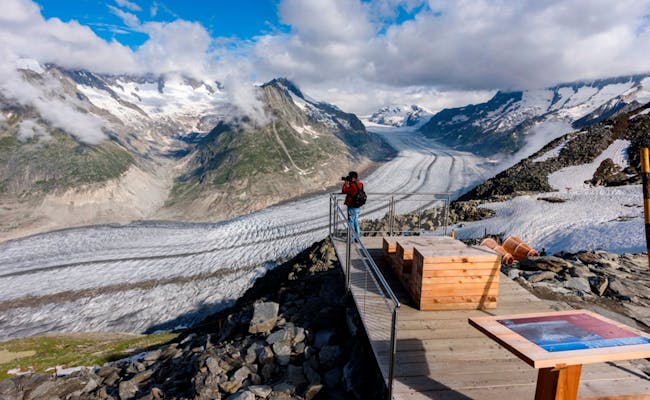 Eggishorn (Foto: Gisella Motta Aletsch Arena)
Eggishorn (Foto: Gisella Motta Aletsch Arena)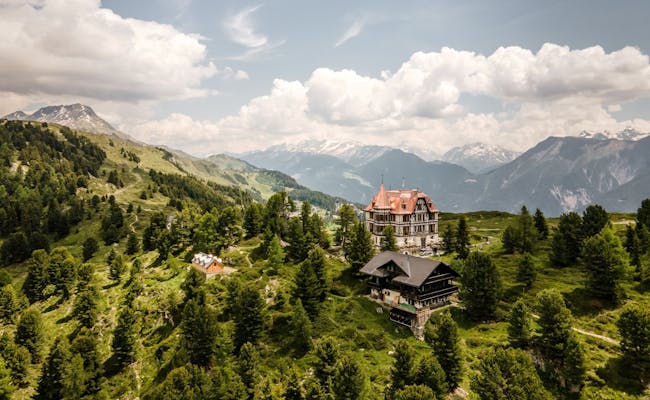 Villa Cassel Pro Natura (Foto: Aletsch Arena)
Villa Cassel Pro Natura (Foto: Aletsch Arena)The discovery pass in the Aletsch Arena
The Aletsch Entdeckerpass is a day ticket that includes the following facilities:
- Train line Brig-Mörel-Betten valley station-Fiesch-Fürgangen
- Sport bus Fiesch-Fieschertal in winter
- all facilities leading to all excursion peaks
- all facilities with adjacent hiking trails
This includes all feeder facilities leading up to the plateau from the valley, the four View Point facilities Hohfluh, Moosfluh, Bettmerhorn and Eggishorn, as well as the ascent of the chairlift Wurzenbord. You have unlimited use of all facilities on the days booked, i.e. as often as you like.
The Valais Adventure Card in the Aletsch Arena
The Erlebniscard Wallis is valid in the Aletsch Arena. You can use it on all Aletsch cable cars.
With the ErlebnisCard you can travel flexibly on 2, 3 or 5 freely selectable days of a month. It allows you to travel through the vacation regions of Upper Valais, Andermatt, Bernese Oberland and Disentis-Sedrun.
Activities in the Aletsch Arena
The Aletsch Arena is very popular for hiking in summer. The car-free area is well suited for this. Mountain huts in the area usually have mass camps, so that hikes lasting several days can be organized.
Activities in the summer include first and foremost:
- Summer hiking routes through the Aletsch Arena and in the Aletsch forest
- Climbing garden, alpine climbing, rope parks and fixed rope routes
- Mountainbiking, mountaincart and trotinett
- Yoga
- Golf and minigolf, tennis
- Guided glacier tours
- Paragliding (all year round)
In winter, in addition to ski slopes and cross-country ski trails, the region also offers groomed hiking trails and sledding slopes. Off the prepared trails, snowshoe tours are popular
Among the most popular winter activities are:
- Winter hiking, snowshoeing and cross-country skiing
- Skiing, snowboarding and sledding
- Ice skating and curling
Summer hiking routes through the Aletsch Arena and in the Aletsch Forest
Below the Jungfraujoch and below the Aletsch Glacier, 150 hiking routes through the Aletsch Arena are available in summer. The Aletsch Forest, which begins to the south of the Jungfraujoch and above the foothills of the Aletsch Glacier, is a particularly popular hiking area for easy to moderate hikes with the whole family. Suitable is the time from mid-June to mid-October.
Examples of easy summer hikes:
- Theme trail Marmot Learning Trail from Bettmeralp to Bettmersee (4.4 km, 1 hr 40 min, 8 meters (hm) ascent, 270 hm descent): knowledge about marmots is imparted at four information stations; marmot families can often be observed along the way.
- Theme trail Rundweg am Eggishorn (500 meters, 20 min, 24 hm ascent and descent), from the top station of the Eggishorn cable car 9 glacier lounges with information panels are passed, from which special views of the surrounding mountains are possible.
Examples of medium-difficulty summer hikes:
- Theme trail Erlebnispfad (ridge trail) from Moosfluh to Riederfurka/Riederalp (6.7 km, 2 hrs 40 min, 447 hm ascent, 430 hm descent): along the way there are five experience stations that take a closer look at topics such as alpine farming, tourism and nature conservation in a playful and acoustic way.
- Hike from Fieschertal via Unnerbärg, Märjelensee to Fiescheralp (12.8 km, 5 hrs, 1293 hm ascent, 192 hm descent): the hike goes mainly upwards over scree and rock, partly over mountain meadows; good physical condition is required. The trail passes a waterfall.
- Circular hiking trail from Bettmerhorn via Märjelensee to Bettmeralp (14.9 km, 5 hrs. 30 min., 233 hm ascent, 949 hm descent): with a view of the Great Aletsch Glacier, the hike goes slightly downhill, over stairs carved in stone towards Märjela, Märjelensee and back to the sunny plateau.
Example of difficult summer hikes:
- Great Three Lakes Hike Bettmersee, Blausee, Märjelensee (20.6 km, 6 hrs. 30 min., 750 hm ascent and descent): Bettmeralp is the starting and ending point of the tour. The illuminated Tälligrattunnel (Oberes Tälli) is also crossed.
Examples of hikes through the Aletsch forest:
- Bettmeralp-Aletschwald (12 km, 4.3 hrs, 130 hm ascent, 55 hm descent): the hike leads from Bettmeralp to Bettmersee, along the lake to the Gopplerlücke fork. Here begins the ascent via Riederalp to Riederfurka. Afterwards it takes about 30 minutes through the Aletsch forest to the open view of the Aletsch glacier. Via Alte Stafel the trail continues towards Biel and crosses to the other side of the ridge. The last part of the trail leads along the southern Bettmersee and back to Bettmeralp.
- Kühboden (Fischeralp)-Aletschwald-Riederalp (12 km, 4 hrs, 497 hm ascent): At the middle station of the Eggishorn cable car the trail starts and leads over Bettmeralp to Moosfluh. On a panoramic path the tour goes in a big arc to the Aletschwald and down to the Silbersand. Over the Riederfurka, the Riederalp is reached on the further way.
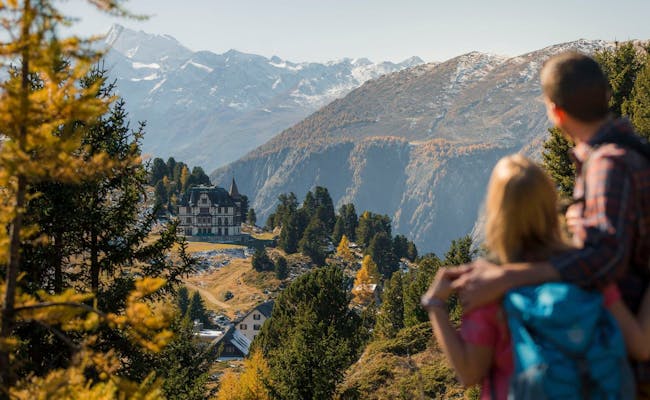 Herbstwandern (Foto: Aletsch Arena)
Herbstwandern (Foto: Aletsch Arena) Winterwandern (Foto: Aletsch Arena)
Winterwandern (Foto: Aletsch Arena)Climbing garden, alpine climbing and via ferrata in the Aletsch Arena
The best way to train alpine climbing is in a climbing garden. Within the Aletsch Arena, in addition to a large climbing garden, there are also opportunities for alpine climbing. Alpine climbing requires more skill and practice than via ferrata.
Climbing Garden Adler
Between Bettmeralp and Riederalp is the climbing garden behind the restaurant Adler. The climbing garden has 18 routes. The maximum wall height here is twenty-five meters.
Fusshorn XI 3155m west ridge
The ascent of Fusshorn number XI, also called Thumb, is very difficult and needs practice in alpine climbing. The granite tower is a popular photo object.
The via Ferrata Aletsch at the Gibidum Reservoir
The via ferrata leads around the Gibidum reservoir in the upper Massa gorge. The route is secured with ropes and steel hooks. Several dizzying climbing passages lie along the way, including an 80-meter river crossing over the 40-meter-high Nepal Bridge. It crosses Massa at the mouth into the Gibidum reservoir.
Via Ferrata Eggishorn
Climbing over a ridge, over steep passages and a 40 meter long three-rope bridge are on the way. The via ferrata on the Eggishorn can also be done with young people who are free from giddiness and sure-footed. There are no overhanging sections. There is an emergency exit after about an hour of climbing.
 Klettergarten Riederalp (Foto: Aletsch Arena)
Klettergarten Riederalp (Foto: Aletsch Arena) Fiescheralp (Foto: Aletsch Arena)
Fiescheralp (Foto: Aletsch Arena)Rope parks in the Aletsch Arena
The Aletsch Arena has two rope parks, the Fiesch Rope Park and the Baschweri Rope Park. High up in the treetops of the Baschweri Rope Park on Bettmeralp and the Swiss Rope Park Fiesch, family fun is guaranteed on a total of 13 courses.
Mastering the obstacles in the trees requires skill - and a little courage here and there. Helmets and gloves are easily available on site. The Baschweri Rope Park, located on the forest path in the direction of Fiescheralp, can be easily reached on foot in about 15 minutes from the Bettmeralp mountain station. The Swiss Rope Park Fiesch is located on the premises of the Sport Resort in Fiesch. You can register at the reception. Have fun with your climbing adventure.
Rope Park Fiesch
The Rope Park Fiesch is part of the Sport Resort Fiesch, which has other sports facilities such as a tennis court and an indoor swimming pool. Overnight accommodations are also available here. The Fiesch Rope Park is modeled after the topography of Switzerland. It takes at least three hours to complete all the facilities. One of the facilities is designed directly for wheelchair users. The rope park works with a new safety system. Helmets and gloves are provided.
The starting point for individual guests is usually at the tree bar. For groups it is located at the Equipment Base - Chalet Ahorn. The tree bar can be found next to the stairs to the restaurant.
The rope park is open from July to about mid-October.
Highlights of the rope park:
- 6 courses with 55 platforms
- 1 course for wheelchair users
- Travel game through Switzerland with cartoon exhibition
Rope Park Baschweri
The Baschweri Rope Park is located on Bettmeralp at an altitude of almost 2000 meters. It is the highest rope park in Switzerland.
Highlights of the rope park:
- 6 courses with a 200 meter long tyrolienne for minimum height 135 cm and maximum weight 120 kg
- Children's course with wooden bridge, net, tyrolienne, rope, wooden tube, rope bridge, snowboard and ski for children under 135 cm height (under adult supervision)
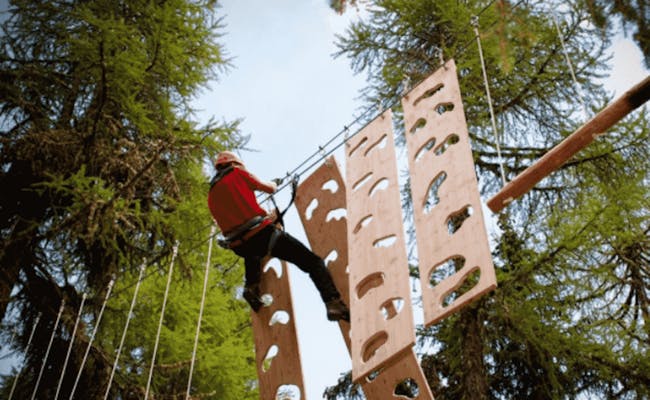 Seilpark Baschweri (Foto: Aletsch Arena)
Seilpark Baschweri (Foto: Aletsch Arena)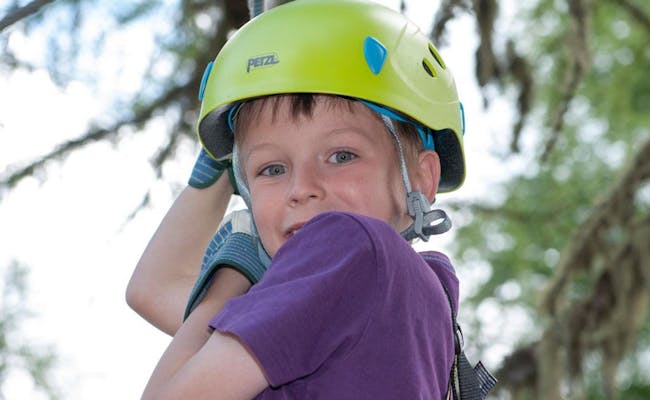 Seilpark Aletsch Arena (Foto: Aletsch Arena)
Seilpark Aletsch Arena (Foto: Aletsch Arena)Mountain bike, mountain cart and trotinett riding in the Aletsch Arena
Mountain bike tours exist within the Aletsch Arena from very short to very long trails. The longest tour is more than 120 kilometers long.
Mountain biking
There are a variety of tours in the Aletsch Arena. The most popular ones are listed here:
Bike-Kidstrack Bettmeralp
Only 400 meters long is the facility where children can practice. At the Bike-Kidstrack they have the opportunity to improve their bike technique.
Fieschertal circuit
11.5 kilometers long is the loop, which is more of a leisurely bike tour. About 350 meters of altitude difference on the whole route are easy to manage.
Aletsch Arena
This tour starts in Kühboden and ends in Fiesch. It is 26 kilometers long and leads almost exclusively (1,600 meters in altitude) downhill.
Rieder Alpenrunde
This demanding tour is almost 20 kilometers long. On the way back to Riederalp, more than six hundred meters of altitude have to be overcome. Alternatively, you can take the cable car from Ried-Mörel to the Aletsch plateau.
Freichirunde: from Fiesch to Schinerewysse
The 46-kilometer tour is considered difficult. It leads from Fiesch up to Schinerewysse and back again. About 1,500 meters in altitude have to be mastered in both directions.
Stoneman Glaciara
4.700 meters of altitude and a distance of 127 kilometers have to be mastered on this mammoth route. The Stoneman route can be completed in several days. Over three stages, the route leads up to the Aletsch region and back to Mörel.
 Trotinett (Foto: Aletsch Arena)
Trotinett (Foto: Aletsch Arena)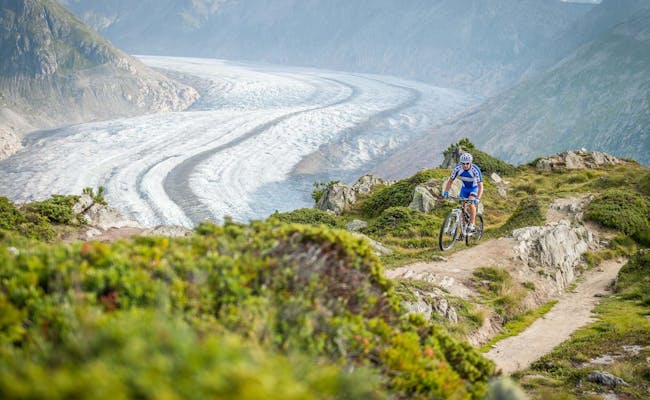 Stoneman Glaciara (Foto: Aletsch Arena)
Stoneman Glaciara (Foto: Aletsch Arena)Mountancart and scooter ride
A mountaincart is a mixture of a GO-cart and a sled. A scooter is a mixture of scooter and e-bike. Both vehicles can be rented on site in the Aletsch Arena including helmet. The following tours are possible:
- Mountaincart - Tour from the Blausee to Riederalp with a length of about 2.8 km and a driving time of 10 minutes (easy to drive)
- Scooter - tour from Bettmeralp to Betten-Dorf with a length of about 8.8 km and a riding time of 70 minutes (easy to ride)
Yoga in the Aletsch Arena
Yoga finds a suitable setting in the Aletsch Arena. Perform meditative yoga exercises while gazing at the glacier, forest or mountain landscape. The yoga instructors Karin Bittel and Steffi Mattig offer the following activities, for example:
- Yoga at sunrise (Bettmeralp), alternatively hike
- Evening yoga with Karin (Bettmeralp)
- Forest bathing and yoga in the Aletsch forest (Riederalp)
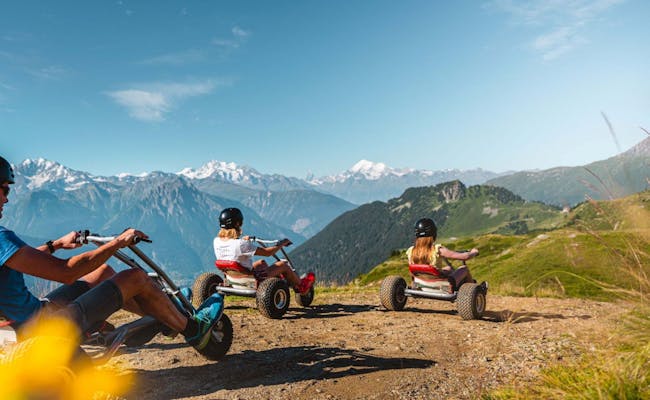 Mountaincart (Foto: Aletsch Arena)
Mountaincart (Foto: Aletsch Arena)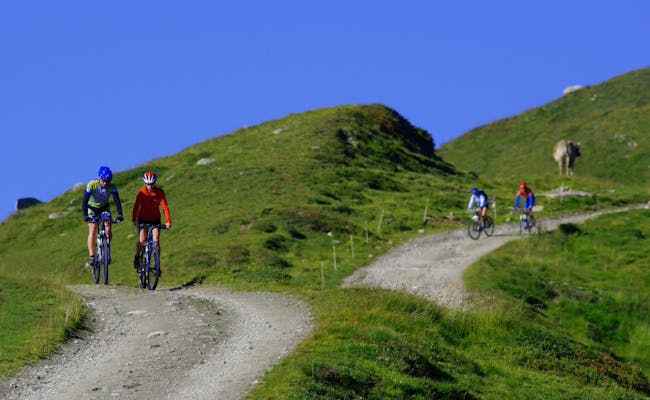 Mountainbiking (Foto: Aletsch Arena)
Mountainbiking (Foto: Aletsch Arena)Golf and mini golf and tennis in the Aletsch Arena
The facilities for mini golf in the Aletsch Arena mostly belong to hotels or restaurants, which also rent clubs, balls and other accessories. For golf, a golf club is located in Riederalp and tennis is available in Fiesch, Riederalp and Bettmeralp.
Golf
Riederalp has a golf club and a golf hotel, the Riederhof. The 9-hole golf course, open every year from about June, is situated at 2,000 meters above sea level. Beginners' courses can be booked directly with the golf club. Golf tournament weeks are held in August and September.
Minigolf
Within the Aletsch Arena there are three minigolf courses with different opening hours:
- Minigolf Mettmeralp (opens 2 p.m.) at the Hotel Garni Sporting with 18 facilities
- Minigolf Disc-Golf Sport Resort Fiesch (open until 12 noon) with 16 facilities and a disc golf course,
- Minigolf Riederalp (open 10 a.m. to 5 p.m.) in front of the Restaurant Edelweiss, additionally with flow trail, pump track, minigolf, slackline and bouncy castles.
Tennis
Tennis courts are available in Riederalp, Bettmeralp and Fiesch:
- Tennis and Fitness Center Fiesch: indoor hall with 3 tennis courts (also for badminton) and 2 tennis courts (outdoor),
- Tennis-Outdoor Bettmeralp: two outdoor courts Sports Center Bachtla,
- Riederalp tennis court
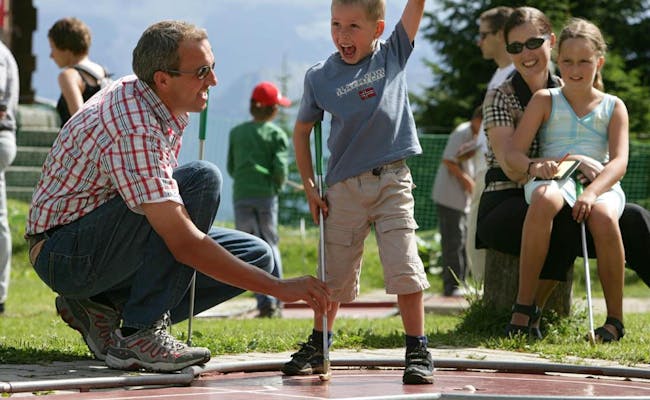 Minigolf Bettmeralp (Foto: Aletsch Arena)
Minigolf Bettmeralp (Foto: Aletsch Arena)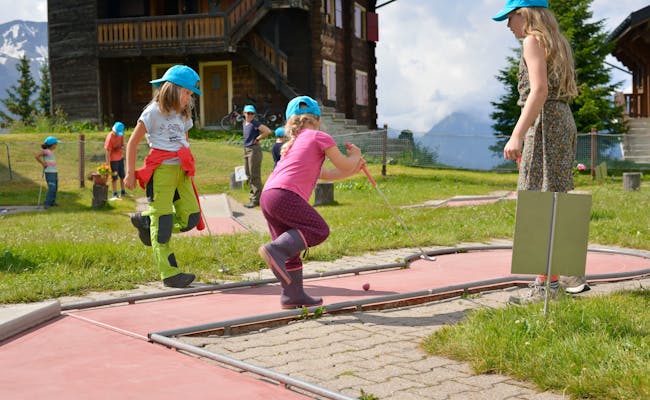 Minigolf (Foto: Aletsch Arena)
Minigolf (Foto: Aletsch Arena)Guided glacier tours in the Aletsch Arena
For safety reasons, a hike across the glaciers is only possible as a guided glacier tour. Local mountain guides take the visitors with them and at dangerous places they are secured with a rope. Too quickly a fall/slide into one of the dangerous crevasses can happen. Without a rope, rescue would be almost impossible in some cases. The necessary equipment here always includes trekking shoes with a good profile. A cap, sunglasses and windproof clothing are very important as the sun and wind can be very strong here. Day lunch and a drink must be taken by yourself. Hiking poles are also helpful. Phenomena of glacier ice and exciting information about the history of the Aletsch Glacier will be given along the way.
Popular, for example, are these glacier hikes organized by the Aletsch mountaineering center.
Cat holes
The glacier hike starts and ends at Bettmeralp. Guided tour to the Aletsch glacier (duration approx. 7.5 hours, June to early August). Surefootedness is a prerequisite, children from 7 years of age may also participate.
A weekend on the glacier
On one weekend you will hike 2-3 hours over the Aletsch glacier with a mountain rope. The total hiking time is about 6 hours. The tour starts in Fiesch or on the Fiescheralp and begins with a descent from the Eggishorn to the Gletscherstube at the Märjelensee. After the glacier hike, the trail leads through the illuminated Tälligrat tunnel back to Fiescheralp. Overnight stay in a hotel. Possible from June to October.
Glacier tour to Konkordia
This is also a guided tour over two days. Overnight stay in the Konkordia hut incl. meals. The tour starts in Fiesch. Crampons and climbing harness are required. Feasible June to October.
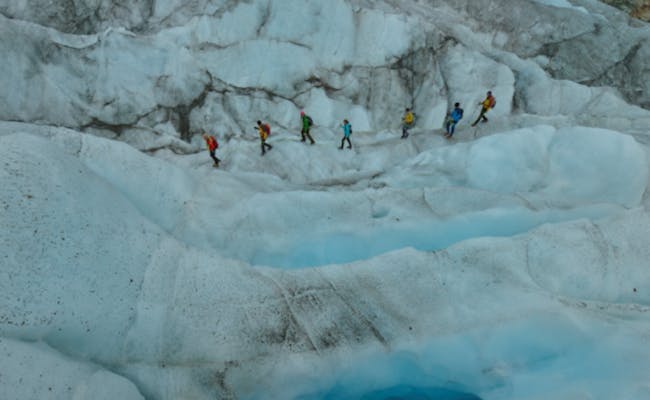 Katzenlöcher (Foto: Aletsch Arena)
Katzenlöcher (Foto: Aletsch Arena) Konkordia (Foto: Aletsch Arena)
Konkordia (Foto: Aletsch Arena)Paragliding in the Aletsch Arena
A popular jumping-off point for paragliding is located in the Fiescheralp above Fiesch. But there are also beautiful jumping-off points on Riederalp and Bettmeralp.
Offers at Swiss Activities:
- Paragliding Tandemab Fiesch
- In a wheelchair paragliding tandem down Fiesch
- For children tandem paragliding from Fiesch
- Paragliding in tandem from Riederalp
Provider of tandem flights:
- Flight Taxi
- Airvolution - paragliding & delta flying
- Flying Center Oberwallis - paragliding school tandem flights
- Flight group Aletsch
- Passenger flight - Delta tandem flights
Passenger paragliding flights (using the example of the provider Flug Taxi):
The take off is from Fiescheralp, Riederalp or Bellwald. Participation is possible from the age of 3 years, the maximum weight is 120 kilograms.
Paragliding Tandem Flight Basic
A tandem flight "Basic" takes about 15 minutes and is a quiet flight over the Aletsch Arena. It is an ideal flight for beginners.
Paragliding Tandem Flight High Fly
On this tandem flight, the focus is on taking off and letting yourself drift with the thermals. It lasts between 20 and 30 minutes.
Paragliding Tandem Flight Eagle
This tandem flight is a long flight of about 45 minutes. During this flight the thermals are used as if by an eagle. The flight goes from one thermal to another.
Paragliding tandem flight barrier free
The flight is made with a wheelchair specially made for paragliding. Children from 6 years of age can participate. The maximum weight here is 80 kilograms of body weight.
Paragliding Tandem Flight Kids Flight Gletschi
This flight is a special flight for children between the ages of 3 and 10. It starts early in the morning so that the air is still calm. The impressions for the children are most lasting in this time.
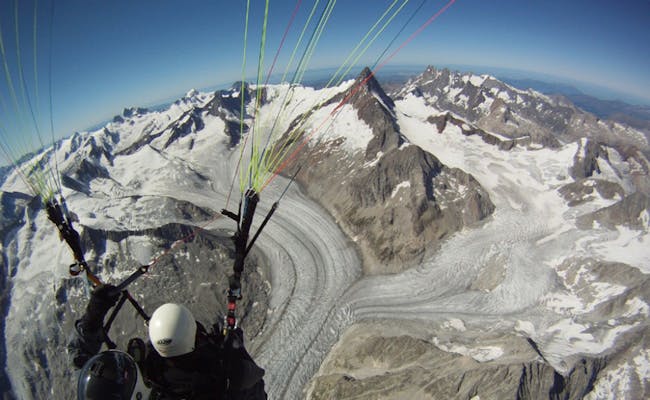 (Foto: Glacier Flyingcenter Hansi Zeiter Aletsch Arena)
(Foto: Glacier Flyingcenter Hansi Zeiter Aletsch Arena)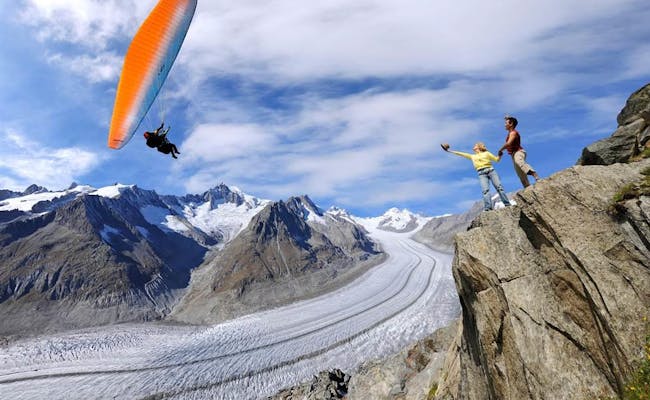 Tandemflug Gletscher (Foto: Aletsch Arena )
Tandemflug Gletscher (Foto: Aletsch Arena )Winter hiking, snowshoeing and cross-country skiing in the Aletsch Arena
In winter, nature on the Aletsch Arena is transformed into a snow paradise with groomed slopes and hiking trails. Snowshoe hikers walk away from the ski carousel on unprepared trails.
Winter hiking in the Aletsch Forest and the Aletsch Arena
72 kilometers of winter hiking trails are groomed in the Aletsch Arena in winter.
Winter hiking tour Bettmeralp "Waldpromenade"
This easy hike has no major differences in altitude to overcome, as it is carried out on the sunny plateau. Starting point is the mountain station of Bettmeralp. The path leads past the Hotel Aletsch at the eastern end of the village and on through the Baschweri. After about 30 minutes of walking in the direction of Martisbergeralp, the path makes a 180° turn and leads back to the west. In the direction of Alte Stafel it goes past the Möriken camp and back to Bettmeralp.
Winter hike from Fiescheralp to Riederalp
This winter hiking trail leads across the entire sunny plateau of the Aletsch Arena. Only 63 meters of altitude difference have to be overcome, but the more than 9 km long route is rather classified as moderately difficult. The tour starts from the mountain station of the Fiesch cable car and leads past the Martisberger and Laxer Alps with their snow-covered slopes. On the Herrenweg it goes to the restaurant Bättmer-Hitta, where a short climb becomes necessary. At Wurzenbord there is a magnificent view of the mountains. Now it goes downhill again. Along the Möriken warehouse and the Hotel Aletsch, the route continues on the village street through Bettmeralp. From the mountain station of the Bettmeralp cable car the further way leads to Riederalp.
 Bettmerhorn (Foto: Christian Pfammatter Aletsch Arena)
Bettmerhorn (Foto: Christian Pfammatter Aletsch Arena)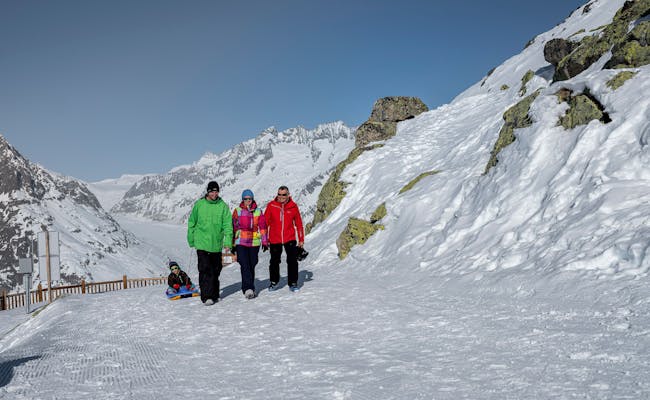 Bettmerhorn (Foto: Christian Pfammatter Aletsch Arena)
Bettmerhorn (Foto: Christian Pfammatter Aletsch Arena)Snowshoe trails through the Aletsch Arena
A multitude of snowshoe trails lead through the Aletsch Arena. Among them are quite a few snowshoe trails, where several hundred meters of altitude have to be climbed. From December to mid-April snowshoe hikes through the Aletsch Forest and in the Aletsch Arena are possible.
easy snowshoe hike Golmenegg
The well-marked circular trail starts at the Golmenegg restaurant. There are about 240 meters of altitude to climb up and down. This trail is well suited for beginners.
Snowshoe trail Holzji trail
The Holzji trail starts in Blatten and leads via Rischinen and Egga to Holzji and on to the Aletschbord. The 800 meters in altitude that have to be climbed make the trail a difficult one, whose efforts are forgotten with the view from the Aletschbord. From here, the Great Aletsch Glacier can be seen very well.
Riederalp
At the cable car station the path starts in western direction. After Nieschbord it goes through the forest and follows the panoramic path and ends in Greich. From here you can take the cable car back to Mörel.
Moosfluh-Riederfurka
The trail starts at the Moosfluh, which is reached by cable car at an altitude of 2333 meters. Over the mountain ridge, the trail leads along the ancient moraine path through the Aletsch forest and on to Riederfurka. During the snowshoe hike, views into the Rhone valley, to the mountain scenery of the 4000-meter peaks and to the Aletsch glacier are possible.
Moosfluh valley station to the mountain station
With 447 meters of ascent, this snowshoe hike is a moderately difficult trip. The 5.6 km long route is walked in about 1 1/4 hours. The tour can also be done in reverse.
Cross-country skiing in the Aletsch Arena
The cross-country skiing trails are often used by skaters as well. They are usually about one to two kilometers long.
Cross-country ski trail Bux Riederalp Skating
From the top station of the Riederalp Mitte cable car, you can get to the cross-country ski trail by driving up past a detached chalet vis-à-vis the top station. Alternatively, a small road to the right of the Hotel Riederhof leads to the top. This trail is little more than a kilometer long and is intended for skating laps. There is also a possibility for classic skiing at this point.
Cross-country skiing track Fiesch Fieschertal
This cross-country trail is just over 2.4 km long. Here cross-country skiing in classic style and skating is possible. The trail is designed as a circular route.
Cross-country skiing trail at Bettmersee, Bettmeralp
The two-kilometer-long cross-country trail can be used for skating and classic style. From the top station of the Bettmeralp cable car, the trail first leads through the village. The winter hiking trail leads eastwards up to the Bettmersee. At Bettmersee the cross-country ski trail begins, which first leads along the frozen and snow-covered Bettmersee.
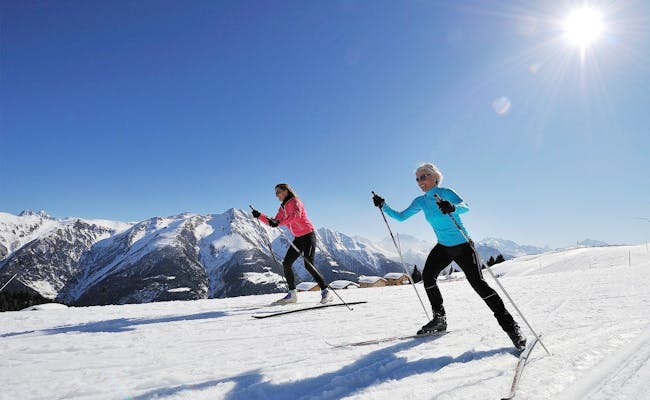 Langlaufloipe Bettmersee (Foto: Aletsch Arena)
Langlaufloipe Bettmersee (Foto: Aletsch Arena) Goms Langlauf (Foto: Aletsch Arena)
Goms Langlauf (Foto: Aletsch Arena)Skiing, snowboarding and tobogganing
35 facilities take winter sports enthusiasts to the top. Eight snow parks alone offer not only sports but also fun and entertainment.
Skiing and snowboarding
In total, the ski area has 124 km of top-prepared slopes. Skiing is possible in the Aletsch Arena at an altitude between 1,845 and 2,869 meters above sea level. Due to the altitude, unadulterated skiing pleasure is guaranteed between December and April. The special feature of these ski slopes is that the large Aletsch glacier is always in view while skiing. The ski area is located directly at the UNESCO World Heritage Swiss Alps Jungfrau-Aletsch.
Ski lifts on the Aletsch Arena
Sixteen ski tows are located on the Aletsch Arena:
- 3 trainer lifts
- 2 Läger
- 2 Alpenrose
- 2 Alpmatten
- Golmenegg
- Schweibe
- Bettmeralp
- Fiescheralp
- Baby lift Blätz-Fieschertal
Sledging and Snowtubing
Sledding in the Aletsch Arena is something special. The region is car-free and has a beautiful panorama. Different slopes for sledging are maintained. For sledging, besides the classic sledges, Snooc skis, Skigibel or Skibock are also suitable. They work very similarly. Snooc skis or sledding equipment can be rented. Sledding is possible from December to April in the Aletsch Arena, in the area Fiescheralp - Laxeralp until about March.
Snowtubing
A 200-meter-long snowtubing track is prepared in winter especially for children next to the Bättma-Hitta. It is located in the Bettmeralp. The use is free of charge and does not need to be registered.
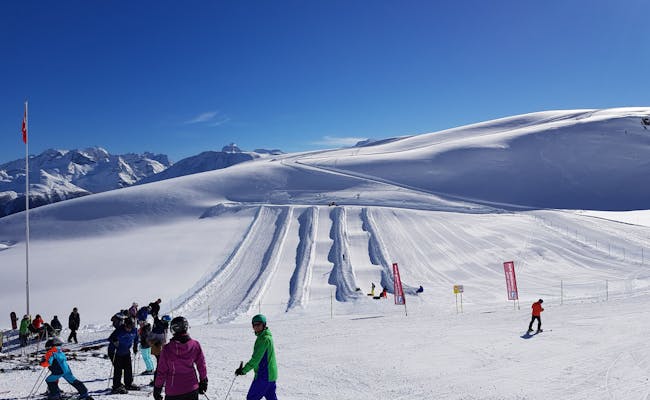 Bettmeralp Snowtubing (Foto: Aletsch Arena)
Bettmeralp Snowtubing (Foto: Aletsch Arena) Riederalp Schlitteln (Foto: Aletsch Arena)
Riederalp Schlitteln (Foto: Aletsch Arena)Here is a selection of the most popular sledding trails:
Moosfluh - Bettmeralp toboggan run
This toboggan run leads down about 300 meters over a length of just under three kilometers. The ride between the top station of the Moosfluh glacier lift at an altitude of 2,333 m to Bettmeralp is correspondingly fast. The slope is also popular for descents with the Snooc. The descent takes about 16 minutes.
Sledging between Moosfluh - Riederalp
This toboggan run leads down 430 meters in altitude over a length of more than three kilometers. It starts at the View Point Moosfluh, which is reached via the combined glacier lift. The toboggan run is also popular for tobogganing tours with the Snooc. It also takes 16 minutes.
Sledging between Fiescheralp - Laxerwald - Lax
Over a length of eleven kilometers, 1,163 meters of altitude are overcome. The ride over a slalom course takes about 36 minutes. From the Fiescheralp mountain station, the run is a 5-minute walk to the east.
Sledding slope Blätz in the Fiesch Valley
The sledding slope incl. children's ski lift is part of a children's and family park. During the season, night sledding also takes place here. Funny figures animate the children.
Sledding slope Chapel Maria zum Schnee Bettmeralp
The toboggan run is located directly next to the Maria zum Schnee chapel in Bettmeralp. It can be used without advance reservation.
Ice skating and curling
Near the sports center Bächtla there is a natural ice rink that can be used for skating and curling.
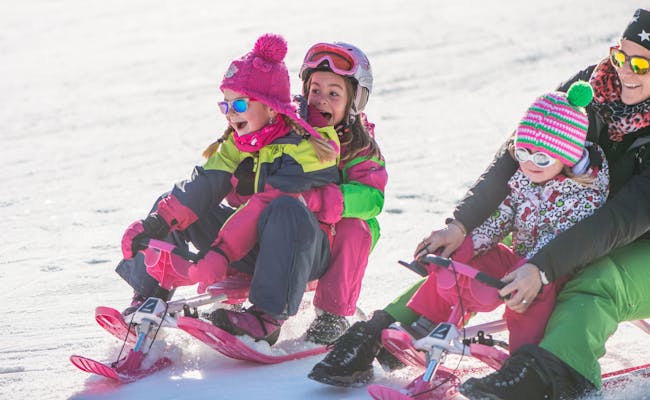 Fieschertal (Foto: Aletsch Arena)
Fieschertal (Foto: Aletsch Arena)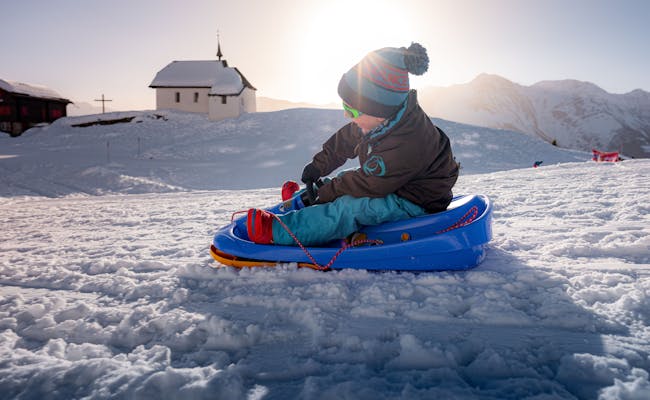 Bettmeralp Schlitteln (Foto: Aletsch Arena)
Bettmeralp Schlitteln (Foto: Aletsch Arena)Mountain railroads of the Aletsch Arena, chairlifts and ski lifts
Mountain railroads of the Aletsch Arena go to Riederalp, Bettmeralp and Fiescheralp with the Eggishorn. In total, the Aletsch Arena has 35 lifts and cable cars that together can transport up to nearly 42000 people per hour. Here you can find a detailed guide about ski resorts in Switzerland including the Aletsch Arena.
To be mobile in the car-free Aletsch Arena, there is the Aletsch Express. Bettmeralp and Riederalp thus offer a shuttle service between the resorts. However, the Aletsch Express does not take luggage. During the summer months, the environmentally friendly electric bus runs every half hour or hour.
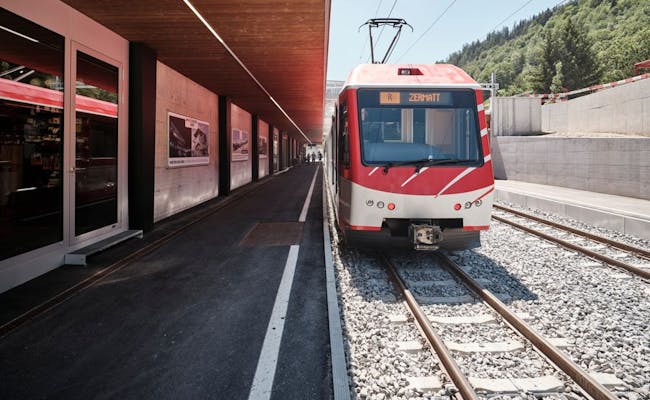 ÖV Fiesch (Foto: Pascal Gertschen)
ÖV Fiesch (Foto: Pascal Gertschen)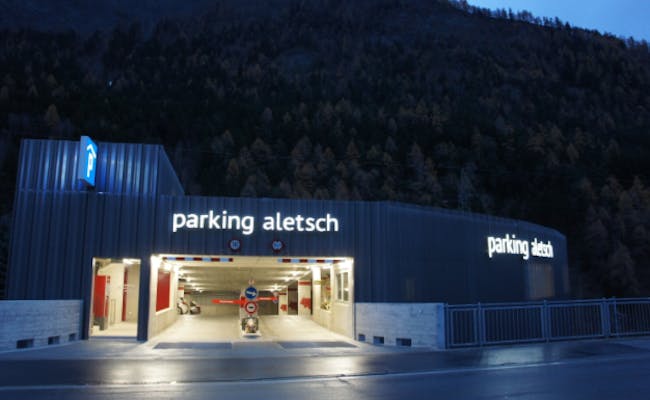 Parking (Foto: Aletsch Arena)
Parking (Foto: Aletsch Arena) Mountain railroads Aletsch Arena: Riederalp
Riederalp is served by two Aletsch Arena cable cars and two chairlifts. In addition, there are two ski lifts.
From Mörel (759 meters) to Riederalp (1925 meters) there are two cable cars. One of the cable cars ends in Ried-Mörel (1188 meters). From here, another cable car takes you to Riederalp West. The other cable car goes directly to Riederalp Mitte. At the middle station in Greich (1361 m) you can get off or on.
Mörel-Greich-Riederalp
The cable car can carry 80 people at the same time. in 2006 the aerial cableway was put into operation, reaching eight meters per second. The cable car covers the distance from Mörel via Greich to Riederalp Mitte in 6:20 minutes.
Facts:
- 759 m a.s.l. bottom station
- 1950 m above sea level top station
- 1141 m altitude difference
- 2798 m Route
- 600 persons/hour
Mörel-Ried-Mörel 1
The 6-person Mörel 1 gondola lift has been in operation since 1996, traveling from Mörel to Ried in 3:50 minutes at a speed of 5 meters per second.
Facts:
- 759 m above sea level bottom station
- 1200 m above sea level top station
- 441 m altitude difference
- 1037 m Route
- 1000 persons/hour
Ried-Mörel-Riederalp 2
The 6-seater Riederalp 2 gondola lift, in operation since 1987, picks up guests in Ried and takes them on to Riederalp. It is a single-cable circulating lift and takes 07:20 minutes. It reaches a speed of five meters per second.
Facts:
- 1200 m above sea level bottom station
- 1950 m above sea level top station
- 750 m altitude difference
- 1980 m route
- 1000 persons/hour
Riederalp-Blausee-Moosfluh combined glacier lift
The Riederalp-Blausee-Moosfluh combined glacier lift offers 8-seater cabins as well as 6-seater chairs. The 18 cabins and 70 chairs hang on the same suspension rope in a 1:4 ratio.
The middle station is not used for boarding and disembarking in winter. Here the mountain changes with the recession of the Aletsch glacier. For this reason, special constructions have been attached to the middle and top stations. In this way, geological subsidence can be compensated for at any time.
The Moosfluh glacier lift was put into operation in 2015. with a speed of 5 meters per second, the combined lift from Riederalp to Moosfluh takes a total of 6:30 minutes.
Facts:
- 1885 m a.s.l. bottom station
- 2335 m above sea level top station
- 450 m altitude difference
- 1754 m Route
- 2400 persons/hour
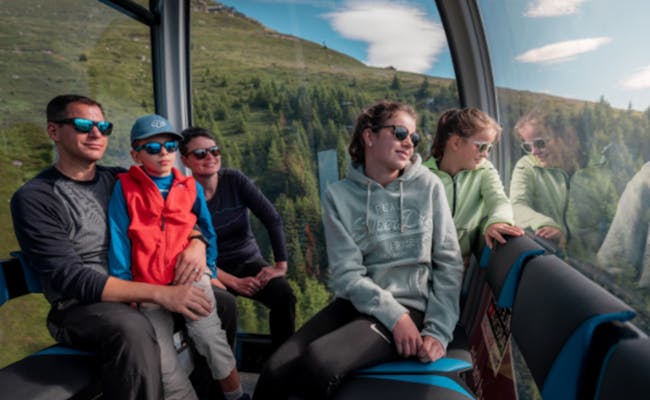 Seilbahn (Foto: Aletsch Arena)
Seilbahn (Foto: Aletsch Arena)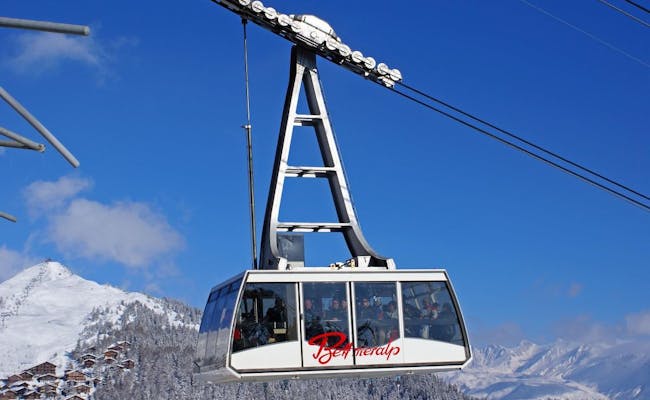 Seilbahn Bettmeralp (Foto: Aletsch Arena)
Seilbahn Bettmeralp (Foto: Aletsch Arena)Mountain railroads Aletsch Arena: Bettmeralp
In addition to the aerial cableways of the Aletsch Arena, there is a gondola lift to the Moosfluh and one to the Bettmerhorn (2647 m). In addition, there are various chairlifts, most of which are reserved for skiers, as well as ski-tow lifts.
From Betten (826 meters) to Bettmeralp (1950 meters) there are two cable cars. One of them initially ends halfway in Betten village (1203 meters). From there a third aerial cableway goes up.
Betten valley station to Bettmeralp
The cabins - aerial cableway holds 125 people. It was built in 1974 and travels between Betten and Bettmeralp at a speed of eight meters per second. For the trip it needs a total travel time of 5:40 min.
Facts:
- 832 m a.s.l. bottom station
- 1933 m above sea level top station
- 1101 m altitude difference
- 2,446 m Route
- 970 persons/hour
Betten valley station to Betten village
From the valley station to Betten-Dorf, the cable car takes 48 people to the top. The cable car was built in 1972 and reaches a speed of seven meters per second. For the distance the cable car needs 2:20 minutes.
Facts:
- 832 m above sea level bottom station
- 1199 m above sea level top station
- 367 m altitude difference
- 872 m Route
- 350 persons/hour
Betten-Dorf to Bettmeralp
From Betten-Dorf to Bettmeralp, the cabin cable car carries 50 people to the top. Built in 1967, the cable car reaches a speed of two meters per second and takes a total of fifteen minutes to cover the distance.
Facts:
- 1199 m a.s.l. bottom station
- 1931 m above sea level top station
- 732 m altitude difference
- 1610 m Route
- 500 persons/hour
Alpmatten (Bettmeralp)
The Alpmatten inclined lift is a funicular for eight people built in 2000. The speed of one meter per second allows a total travel time of 2:30 min.
Facts:
- 1920 m a.s.l. bottom station
- 1959 m above sea level top station
- 30 m altitude difference
- 134 m Route
- 100 persons/hour
Bettmeralp-Bettmerhorn
The 8-person gondola lift from 1995 operates as a single-cable gondola lift from Bettmeralp to Bettmerhorn. With a speed of 5 meters per second, the lift takes 8:30 minutes.
Facts:
- 1991 m a.s.l. bottom station
- 2652 m above sea level top station
- 662 m altitude difference
- 2324 m Route
- 2400 persons/hour
Bettmeralp - Wurzenbord
The 4-seater high-speed chairlift was inaugurated in 2003. It is detachable and has covers. At 5m/s, the chairlift reaches Wurzenbord in just four minutes. Pedestrians are only taken uphill in winter.
Facts:
- 1966 m a.s.l. bottom station
- 2224 m above sea level top station
- 258 m altitude difference
- 1075 m Route
- 2000 persons/hour
Bettmeralp-Schönbiel
The 6-seater high-speed chairlift from 1998 runs from Bettmeralp to Schönbiel in 6:10 minutes. The chairs have covers and are detachable. The speed is 5 meters per second. In winter, pedestrians are not carried.
Facts:
- 1956 m a.s.l. bottom station
- 2296 m above sea level top station
- 340 m altitude difference
- 1670 m Route
- 2800 persons/hour
Bettmeralp-Blausee
The 4-person high-speed chairlift dates from 2010. It is detachable and has orange weather protection hoods. The Bettmeralp-Blausee chairlift has a mid station. The chairs are equipped with child-safe safety bars. The ride takes a total of four minutes at a speed of 5 meters per second.
Facts:
- 1940 m a.s.l. bottom station
- 2207 m above sea level top station
- 267 m altitude difference
- 1079 m Route
- 2000 persons/hour
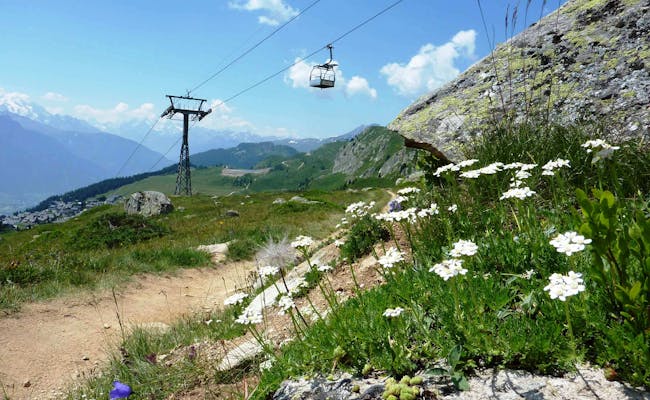 Murmeltier Lernpfad zum Bettmersee (Foto: Aletsch Arena)
Murmeltier Lernpfad zum Bettmersee (Foto: Aletsch Arena) Gletscherbahn Moosfluh Riederalp (Foto: Aletsch Arena)
Gletscherbahn Moosfluh Riederalp (Foto: Aletsch Arena)Riederalp - Hohfluh
Dating from 2009, the 4-seater high-speed chairlift to Hohfluh has covers and is detachable. It runs at 5 meters per second and takes a total of 3:40 minutes.
Facts:
- 1929 m a.s.l. bottom station
- 2227 m above sea level top station
- 296 m altitude difference
- 1010 m Route
- 2000 persons/hour
Riederalp - Riederfurka
The 4-seater chairlift Riederfurka was built in 1993. With the speed of two meters per second, the lift travels six and a half minutes from Riederalp to Riederfurka.
Facts:
- 1876 m above sea level.Bottom station
- 2119 m above sea level top station
- 243 m altitude difference
- 702 m Route
- 2050 persons/hour
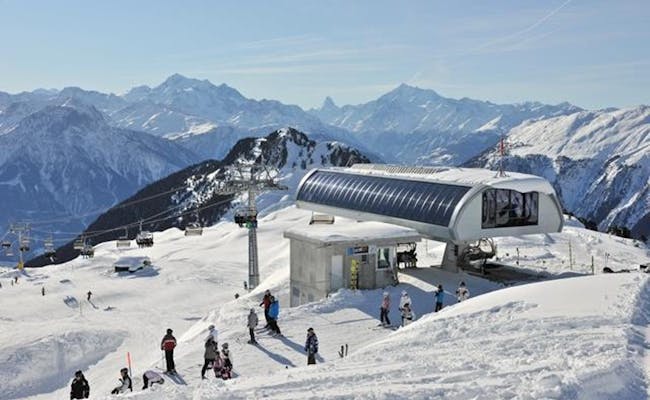 Hohfluhbahn (Foto: Aletsch Arena)
Hohfluhbahn (Foto: Aletsch Arena)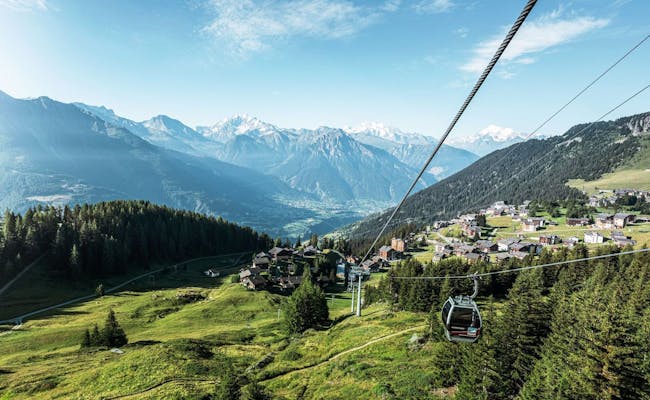 Riederalp (Foto: Aletsch Arena)
Riederalp (Foto: Aletsch Arena)Mountain railroads Aletsch Arena: Fiescheralp / Eggishorn
The Aletsch Arena mountain railroads to Fiescheralp (2227m) and on to Eggishorn (2879) are coordinated. In addition, there are some chairlifts for skiers and ski-tow lifts.
Fiesch-Kühboden
The 10-passenger gondola lift was only inaugurated in 2019. It operates as a single-cable circulating lift between Fiesch and Kühboden. At seven meters per second, the gondola reaches its destination in 7:48 minutes.
Facts:
- 1083 m above sea level bottom station
- 2227 m above sea level top station
- 1144 m altitude difference
- 2698 m Route
- 1880 persons/hour
Fiescheralp-Eggishorn
The cable car, built in 1988, carries 45 people directly to the Eggishorn. It reaches a speed of eight meters per second and takes 4:10 minutes for the total distance.
Facts:
- 2225 m a.s.l. bottom station
- 2879 m above sea level top station
- 654 m altitude difference
- 1836 m Route
- 495 persons/hour
Talegga
The Talegga is a 6-seater high-speed chairlift with covers. The chairlift is detachable. With a speed of five meters per second, the lift reaches in six and a half minutes from Fiescheralp towards Eggishorn. The lift ends just 150 meters below the summit. In winter, the chairlift is reserved exclusively for skiers.
Facts:
- 2205 m a.s.l. bottom station
- 2724 m above sea level top station
- 518 m altitude difference
- 1782 m Route
- 2200 persons/hour
Heimatt-Kühboden
The detachable 4-seater high-speed chairlift runs at the speed of 5 meters per second 4:10 minutes.
Facts:
- 1848 m a.s.l. bottom station
- 2301 m above sea level top station
- 453 m altitude difference
- 1144 m Route
- 1400 persons/hour
Fiescheralp - Flesch
The 4-seater high-speed Flesch chairlift is detachable and has been traveling from Fiescheralp towards Eggishorn since 1993. With the speed of 5 meters per second, the chairlift reaches its destination in five minutes.
Facts:
- 2208 m a.s.l. bottom station
- 2630 m above sea level top station
- 422 m altitude difference
- 1357 m Route
- 2.400 persons/hour
 Bettmersee (Foto: Aletsch Arena)
Bettmersee (Foto: Aletsch Arena) Aletschgletscher Bettmerhorn (Foto: Kaja Aletsch Arena)
Aletschgletscher Bettmerhorn (Foto: Kaja Aletsch Arena)Events in the Aletsch Arena
Numerous events take place in the Aletsch Arena every year. The current event schedule can be found on this page. Prices can also be found here.
Regularly recurring events include:
- Aletsch Half Marathon on a weekend in June
- Walliser Yodel Meeting on a Sunday between mid-June and the end of August
- Red Bull X-Alps Turnpoint Fiesch at the end of June
- Woo Charity Hike in early July (the registration fee is donated to the Greenhope Foundation)
- Story and Fairy Tale World of “Klapperlapapp” on the Fiescheralp in mid-July
- Gala Performance Participation Circus Bettmeralp from mid-July to early August
- Gommer Music Holidays - Guitar in the third week of July
- Aletsch Golf Tournament Week in the second week of August
- Traditional Cassel Festival on the second Sunday in August with open-air service and attractions
- Gommer Music Holidays - Brass Instruments in the second week of August
- The Yodel Trek: Culinary Yodel Hike in mid-August
- Folklore Evening of the Traditional Costume Association in mid-August
- Mountain Glow - the Yoga Festival at the Aletsch Glacier in the first week of September
- Autumn Golf Tournament Week in the first half of September
- Autumn Brunch at Villa Cassel in early September
- Aletsch Trail Challenge on the weekend at the end of September
- Ändi Summer Festival at the Alpmuseum Riederalp in mid-October
- Gommer Advent Market in the third weekend of November
- New Year's Apéro at the Alpmuseum on New Year's Day
- The steepest torch descent in the world from Eggishorn in mid-February
- Stars on Snow - best of electronic music for three days at the end of March
- Aletsch Women’s Run
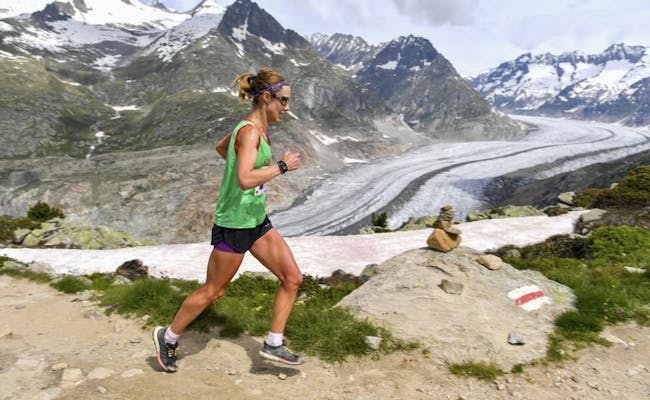 Halbmarathon (Foto: Aletsch Arena)
Halbmarathon (Foto: Aletsch Arena) Yoga (Foto: Aletsch Arena)
Yoga (Foto: Aletsch Arena)Mountain huts within the Aletsch Arena
After hours of hiking through lonely mountain worlds, one would like to stop in a mountain hut. In the area of the Aletsch Arena there are a variety of mountain huts.
Mountain hut Burghütte
The Burghütte, located at 1,744 m at the foot of the Fieschergletscher glacier, is staffed between the beginning of June and mid-October. The Fieschergletscher is the eastern twin glacier of the Aletsch glacier.
For up to 32 people, the hut offers overnight accommodation with full or half board.
Heidi's hut
In Kühboden on the Fiescheralp, Heidi`s Hütte is located below the Heimatt chairlift directly on the ski slope. Heidi's hut is reached by cable car from Fiesch to Fiescheralp and a short walk over the Heimatt.
The hut has 30 seats inside and 60 seats on the terrace. Open daily from 9:30-17:00
Chüestall mountain restaurant
Between Riederalp and Bettmeralp stands the Chüestall mountain restaurant directly on the piste.
Open:
- in summer: Monday to Sunday 09.00 h to 16.30 h
- in winter: Monday to Sunday 09.00 h to 16.30 h
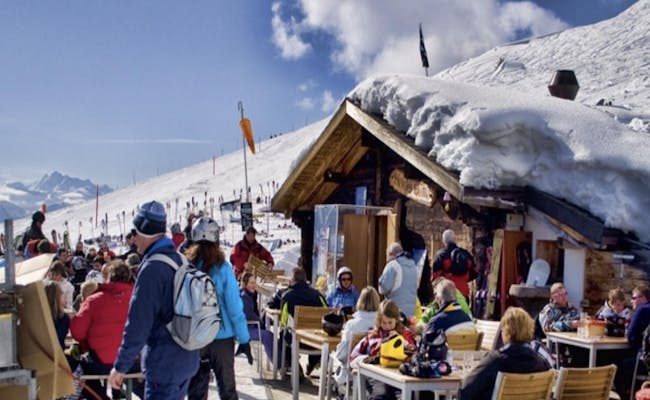 Heidis Hütte (Foto: Aletsch Arena)
Heidis Hütte (Foto: Aletsch Arena) Restaurant Chuestall (Foto: Aletsch Arena)
Restaurant Chuestall (Foto: Aletsch Arena) Bättmer Hitta
Directly on the hiking trail from Fiescheralp to Bettmeralp stands the Bättmer Hitta at an altitude of 2,172 meters (in maps it is sometimes still listed as Furri Hütte). The Herrenweg leads here from Bettmeralp in about 40 minutes, from Fiescheralp it is 30 minutes. From Riederalp it takes 95 minutes.
On foot or by train you can reach the Bettmerhorn from here. The way to the Eggishorn is via Fiescheralp. From the Eggishorn there is a breathtaking view of the Aletsch glacier. From here you walk along the marmot learning path to the Bettmersee. There you can swim or fish (Thursday closed day).
Open daily 10-15, also in the winter season. In summer the hut opens from mid-June to the end of October.
S'Bootshüsi & Castello on Lake Bettmer
Directly on Lake Bettmer there is a boathouse with boat rental, fish patents and snacks. In the high season, grilled food is offered on weekends. The café at S'Bootshüsi is open in summer and in winter guests are served in the Castello pub. S'Bootshüsi & Castello also has a vacation home. Chalet Chrütli has a direct connection to the coach lifts.
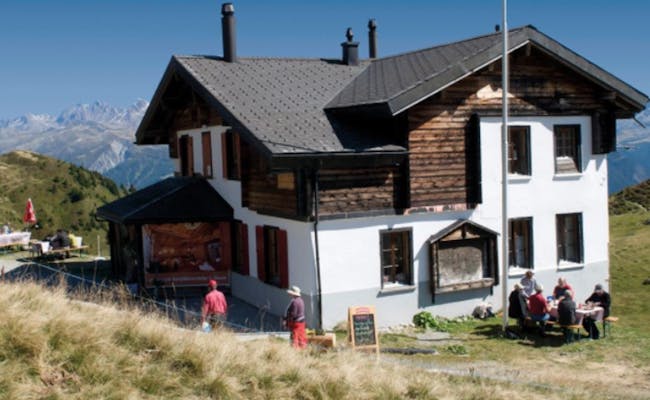 Bättmer Hitta (Foto: Aletsch Arena)
Bättmer Hitta (Foto: Aletsch Arena)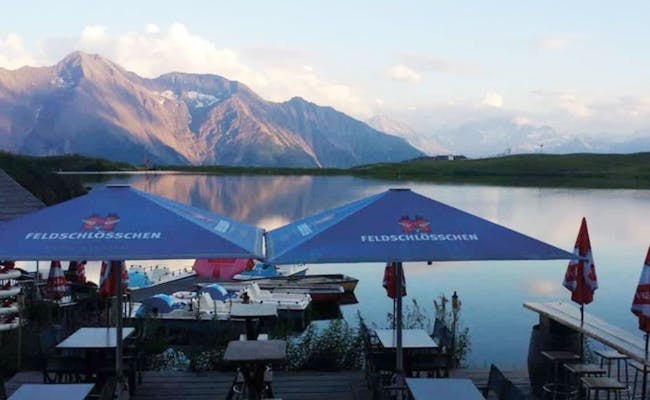 Bettmersee (Foto: Aletsch Arena)
Bettmersee (Foto: Aletsch Arena)Bettmerhorn Panorama Restaurant
The Bettmerhorn Panorama Restaurant stands at 2,647 meters above sea level. Built in 1983, it was remodeled in the fall of 2016. The attractive restaurant on the Bettmerhorn offers an excellent view of the Great Aletsch Glacier.
Bar Buvette
You'll find the Bar Buvette right next to the top station of the Moosfluh glacier cable car and near the View Point. A former cable car cabin serves as a bar. Even from here you have a beautiful view of the Great Aletsch Glacier.
 Panorama Restaurant Bettmerhorn (Foto: Aletsch Arena)
Panorama Restaurant Bettmerhorn (Foto: Aletsch Arena) Bar Buvette Moosfluh (Foto: Aletsch Arena)
Bar Buvette Moosfluh (Foto: Aletsch Arena)Mountain hut Horli-Hitta
The [orli-Hitta stands at an altitude of 2,872 m on the Fiescheralp (Eggishorn). It is reached by the Fiescheralp aerial cableway. Regional specialties such as hut fondue and cheese slices are served and some are self-service.
There are 35 seats inside and 150 seats on the outside terrace. Deck chairs can be rented.
For small celebrations, the shepherd hosts offer romantic hut evenings. Guests are served cheese fondue or Valais raclette. The mountain hut can be reached at +41 (0)27 971 49 19. It is open
- in winter: Mid-December to mid-April
- in summer: mid-June until the end of October
Mountain hut Gletscherstube on the Märjelenalp
At 2,367 m, the Gletscherstube mountain hut stands on the Märjelenalp near the front lake of the Märjelen Lakes. The Gletscherstube is easy to reach from all directions on the well-marked hiking trails of the Aletsch Arena.
Hüttenzauber evenings are offered in the hut. For overnight stay there are three rooms with dormitory for once 10 and twice 12 persons each. Half board is possible.
Open is the Gletscherstube from the beginning of July to mid-October.
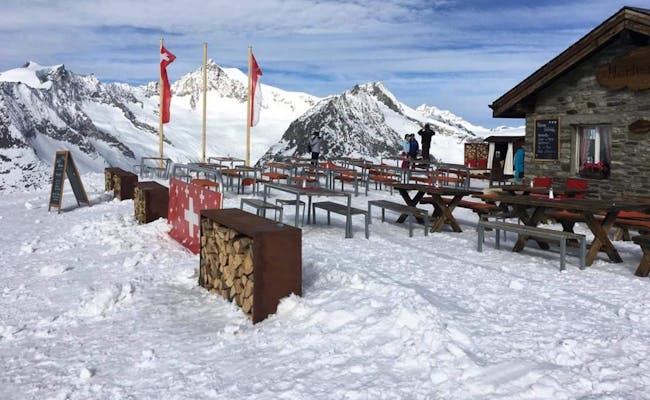 Horli Hütte (Foto: Aletsch Arena)
Horli Hütte (Foto: Aletsch Arena)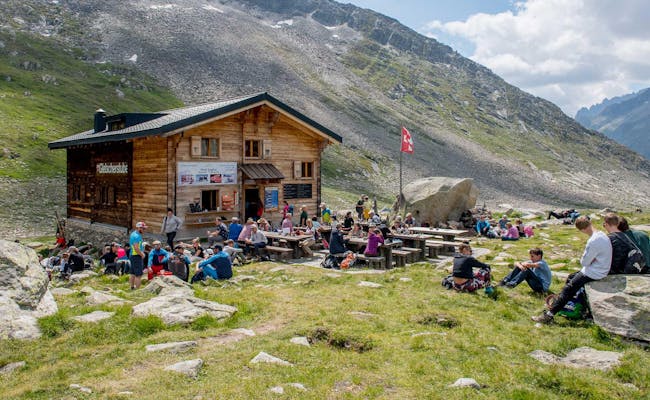 Gletscherstube (Foto: Aletsch Arena)
Gletscherstube (Foto: Aletsch Arena)Climate and weather Aletsch Arena
In the Aletsch Arena there are several south-facing slopes which are spoiled by the sun in summer and winter
The average temperatures in summer are 14 °C in July and August. During the day, however, temperatures of 25 to 27 °C are often reached in the months of June to August. This is also due to an average of 9 hours of sunshine per day in midsummer.
Winter is usually snowy at least from November to March/April. Crystal clear air, sunshine and crunching snow characterize the south facing slopes. On average you can expect 3-4 hours of sunshine in winter.
Due to the altitude between 2000 and almost 3000 m above sea level, there is always a light wind blowing in the area. You should always expect gusts. The UV index here is between 1 and 2, so rather harmless
Aletsch Arena: location and approach
The Aletsch Arena includes the area of the municipalities of Mörel-Filet, Riederalp, Bettmeralp, Fiesch, Fieschertal and Lax. The entire area is part of the UNESCO World Natural Heritage Swiss Alps Jungfrau Aletsch. As it is completely car-free, motorized visitors can only reach the Aletsch Arena by mountain railroads.
The car can be parked at the valley stations Mörel, Betten-Dorf and Fiesch. The cable car is always in the immediate vicinity of the station and the large parking lots or parking garages. Note: Since there is regularly snow on the car-free roads on Riederalp, Bettmeralp and Fiescheralp in winter, it is advisable to book a luggage transport between accommodation and mountain station for the arrival and departure.
Important to know: In winter the passes Furka and Oberalp are closed.
In the municipality of Mörel-Filet (Canton Valais) is the Parking Aletsch. You can find it via the Furka road (Route 19) about 10 km northeast of Brig.The neighboring cable car to Riederalp (Aletsch Arena) is reached in two minutes on foot.
The parking garage can be reached from Geneva in 2:40 hours, from Basel in three hours and from Zurich in 2:45 hours. It is advisable to use the car loading trains in Goppenstein (BLS) or Realp (MGB) for the arrival.
Arrival by public transport is via the Mörel-Riederalp, Betten Talstation-Bettmeralp and Fiesch-Fiescheralp feeder railroads. They run all year round and are part of the GA and half-fare route network of the SBB.

